The Heart of Mythical Japan
f you wanted to get a taste of what feudal Japan might have looked like, the countryside of Takachiho in the Miyazaki prefecture comes pretty close. Largely untouched, the mountainous landscape is spectacularly scenic with small villages and terraced rice paddies scattered here and there. The rolling hills are covered with pine trees and the early morning mist creeps up between the valleys and catches on the mountainous peaks. As dawn begins to break, the sun rays peak through mountain silhouettes as sleepy villagers begin to wake.
I’d be lying if I didn’t say the place felt alive with shinto spirits.
In Takachiho, it’s really not hard to see what inspired the stories and supernatural spirits of Japanese folklore and mythology. While Shintoism seems far removed from most modern Japanese lifestyle, Takachiho is one of the few places where it is so openly and commonly practiced.
Here, we’ve come to marvel at one of the most renowned and uniquely beautiful spots in Kyushu. Descending into Takachiho Gorge, its ancient rock walls reach up to the heavens, showing off ribbed colonnade structures covered in sparkling moss. Stepping into a small rowing boat, we cross the barrier between reality and the spirit realm, enclosed by a canopy of green and orange coloured leaves. Ahead of us, the teal green water of the Gokase river snakes between the curves and bends of the gorge’s walls and flows underneath one of Japan’s top 100 waterfalls, the Manai falls.
As we drift down the waters of the Gokase river, we invite you on a mythical journey to discover the nostalgia of old Japan in Takachiho.
A Volcanic Creation
Located in Kyushu’s Miyazaki Prefecture, Takachiho Gorge has been designated a “Place of Scenic Beauty” and a “Natural Monument” by the Japanese government. As a little bit of background, the term “monument” is used by the Japanese government to declare a historic site a “Cultural Property of Japan”. This declaration is typically applied to sites that have high historic significance, great scenic beauty or natural features that have high scientific value. This law helps to protect Japan’s cultural heritage.
Apart from its obvious scenic beauty, the creation of Takachiho Gorge itself was the culmination of 4 volcanic eruptions from Mount Aso, with the first dating back as far as 270,000 years ago! The lava, volcanic ash and gases resulting from these eruptions, flowed down from Mount Aso and rapidly cooled, creating the unique organ pipe structures that line the base of the gorge. Over time the lava eroded to reveal the V-shaped valley the Gokase river now flows through, leaving behind Takachiho Gorge’s ‘dragon scale’ columns on full display. Today, the cliffs of the gorge reach heights of up to 100m and its length continues for approximately 7 kilometers. These striking geological features are what classifies Takachiho Gorge as an important “Natural Monument”.
In the centre of Takachiho Gorge resides one of Japan’s top 100 waterfalls, the Manai falls. While only a small waterfall of 17 meters in height, its incredible scenic beauty is stunning to behold as natural spring water cascades off the mossy cliff face of the gorge and plunges into its pristine aqua waters.
Takachiho Mythology
ne day, Amaterasu goddess of the sun, looked down upon the Earth from the heavens and wept at the chaos that consumed the land. To restore peace, she sent her grandson, Ninigi no Mokoto to govern the islands of Japan in her honour.
Into a mist covered Takachiho, Ninigi no Mikoto and a procession of deities descended from the heavens carrying three items: the jewel Yasakani no Magatama, the mirror Yata no Kagami and the sword kusanagi no Tsurugi. With him, Ninigi also brought rice and scattered it across the land.
Today, the Kushifuru Shrine near Takachiho Gorge is believed to be the spot where Ninigi and his procession of deities arrived in Japan. It is here on Earth that Ninigi established the Japanese Imperial Family and is the divine ancestor to Japan’s first emperor, Jimmu, Ninigi’s grandson. The three items Nigini brought to Earth with him also formed the Imperial Regalia of Japan.
In the 8th Century, two of Japan’s most ancient history books were published by the Emperor; the Kojiki and Nihonshoki. These books describe Japan’s creation as a continent, the foundation of Japan’s Imperial line and much more through a catalog of songs, myths, legends and oral traditions.
It is here in Takachiho’s misty valleys and mountainous peaks that many of the recorded legends play out across the landscape of Takachiho. Takachiho Gorge itself is also home to Japan’s creation myth where Izanagi and Izanami created the first Japanese island and brought the first source of spring water to the Earthly realm, in a natural well known as Ama Manai. This well is the source of the spring water that flows through the Manai Falls.
For most young Japanese people it seems as if the Shinto mythology that formed the core of their country’s spiritual origins has been lost to the fast paced and modern society we so commonly see today.
With such significant mythological ties, this is not the case in Takachiho. Compared to populated Japanese cities, life here seems to slow down and the native religion of Shintoism is alive, intimately interwoven and vibrantly celebrated among the community. It is both awe-inspiring and magical to behold and will illustrate a historical and spiritual side of Japan you may not be able to witness in most tourist frequented areas.
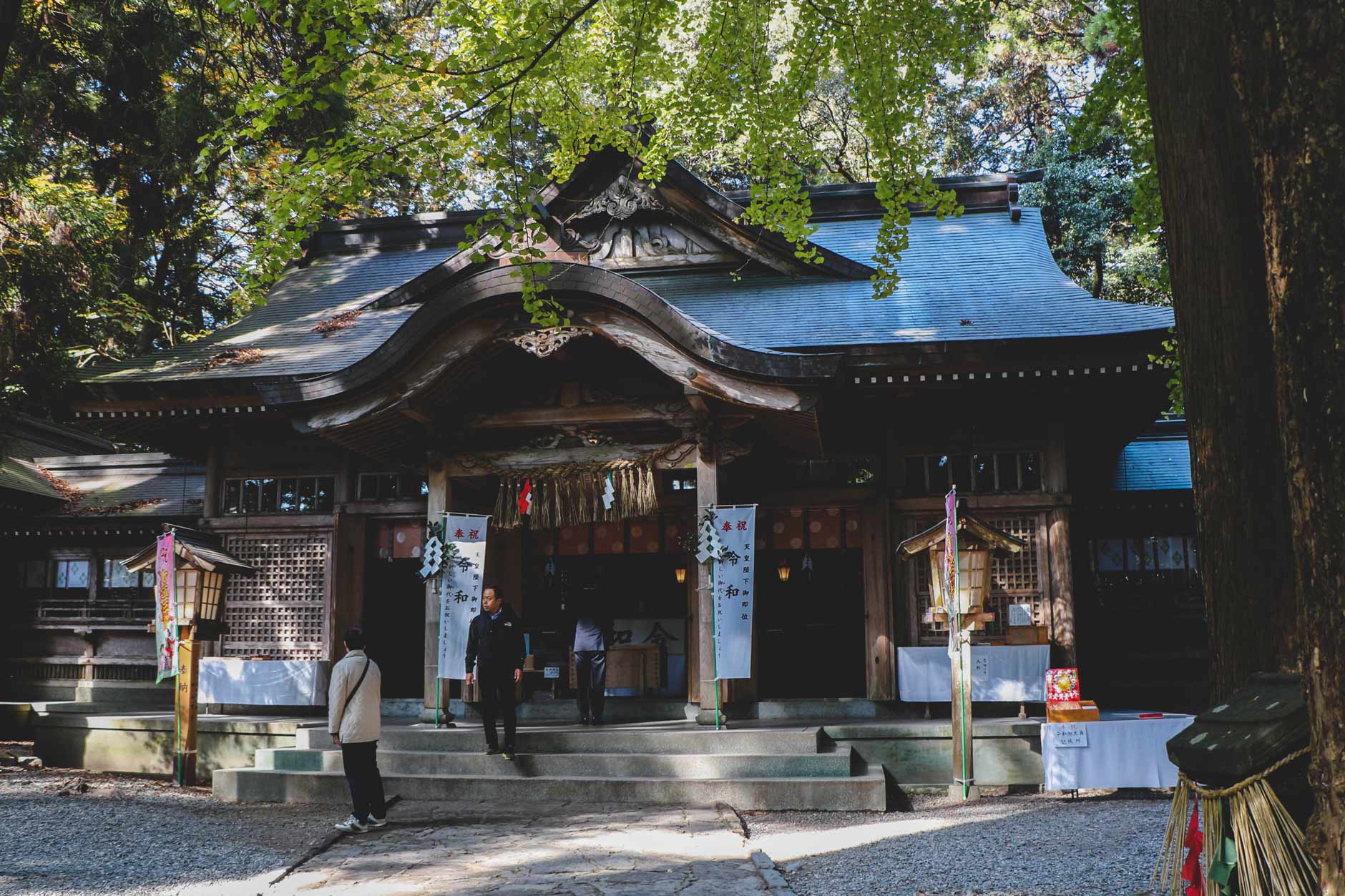
Locals praying at Takachiho Shrine
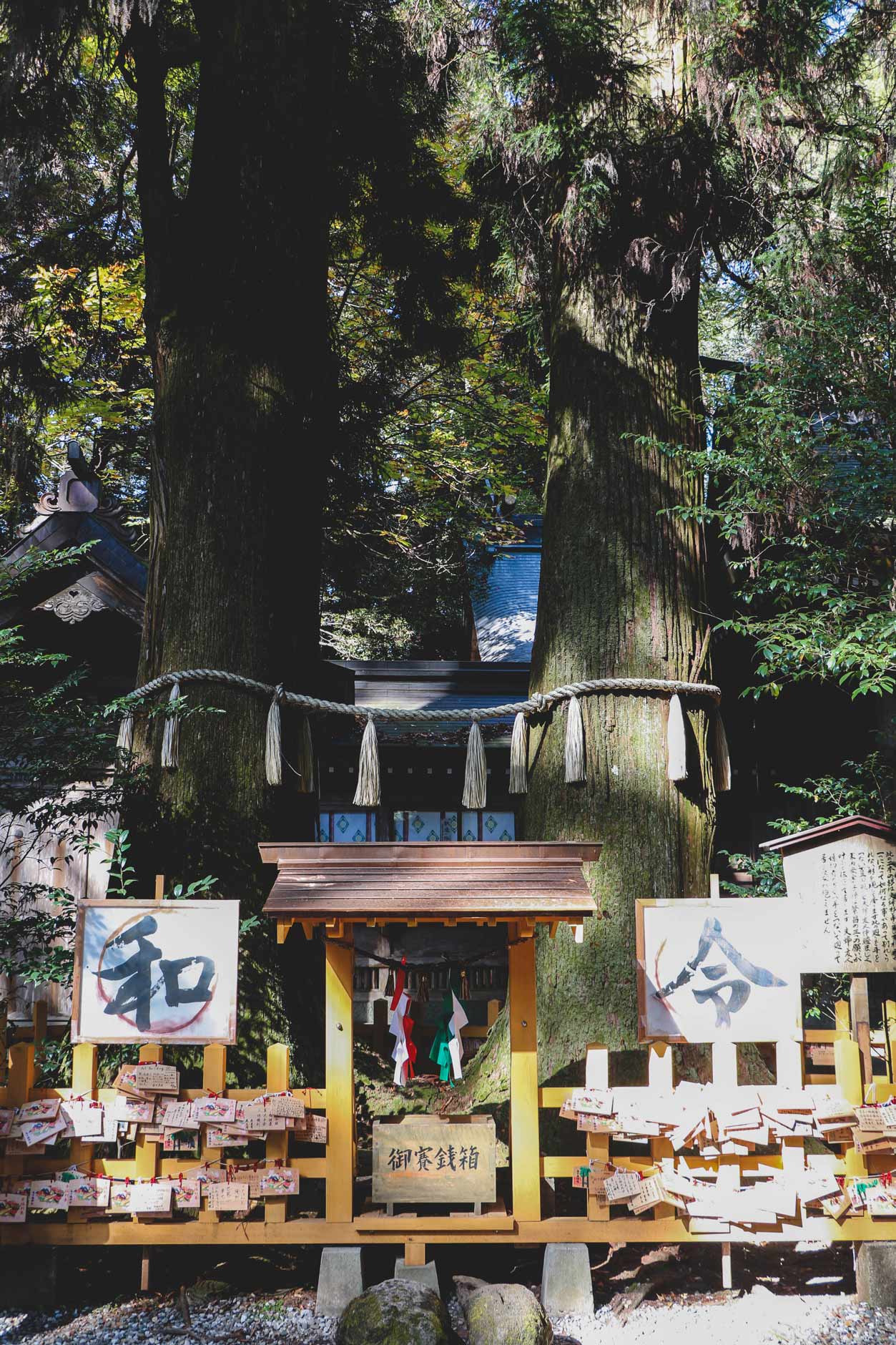
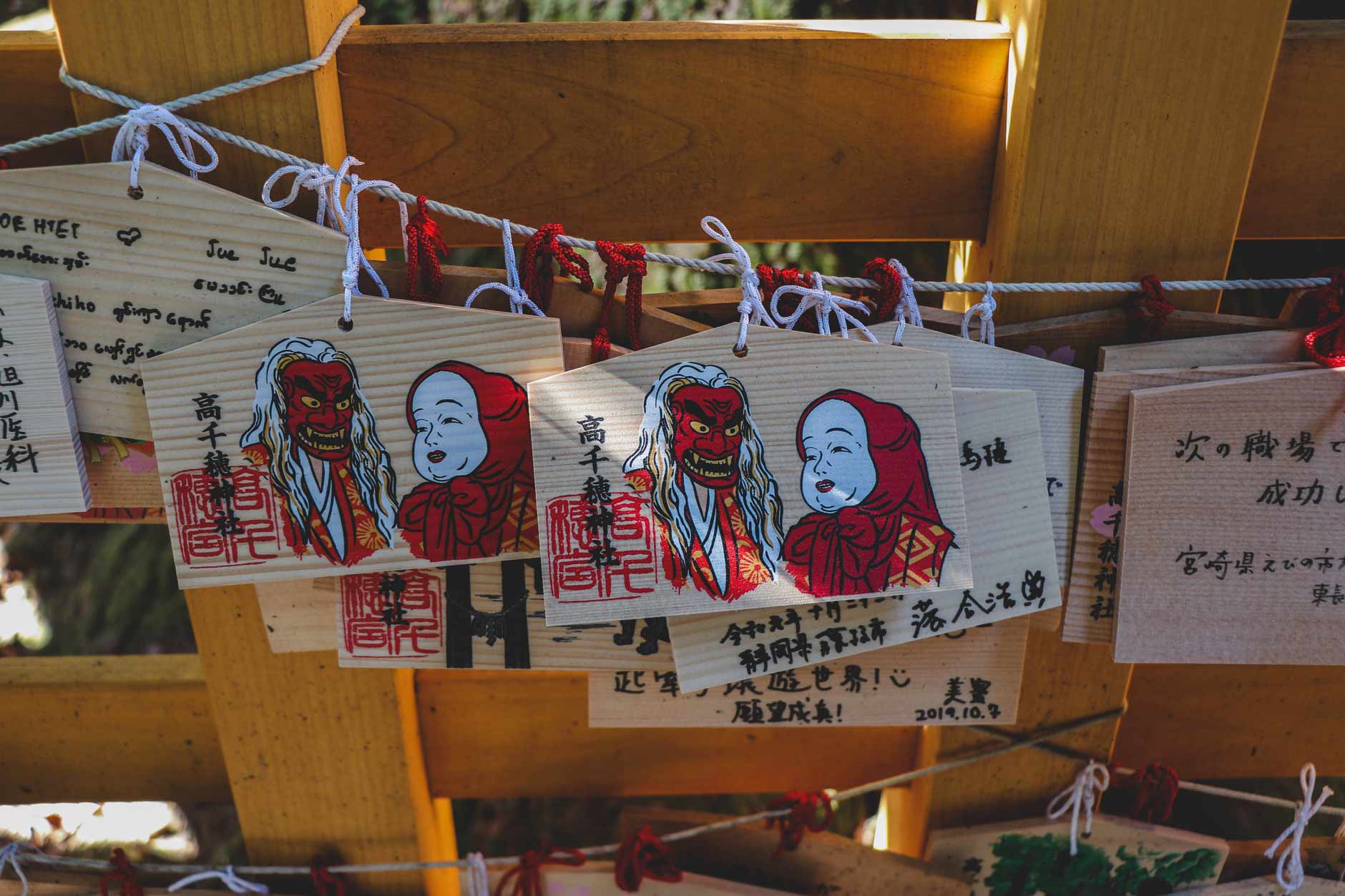
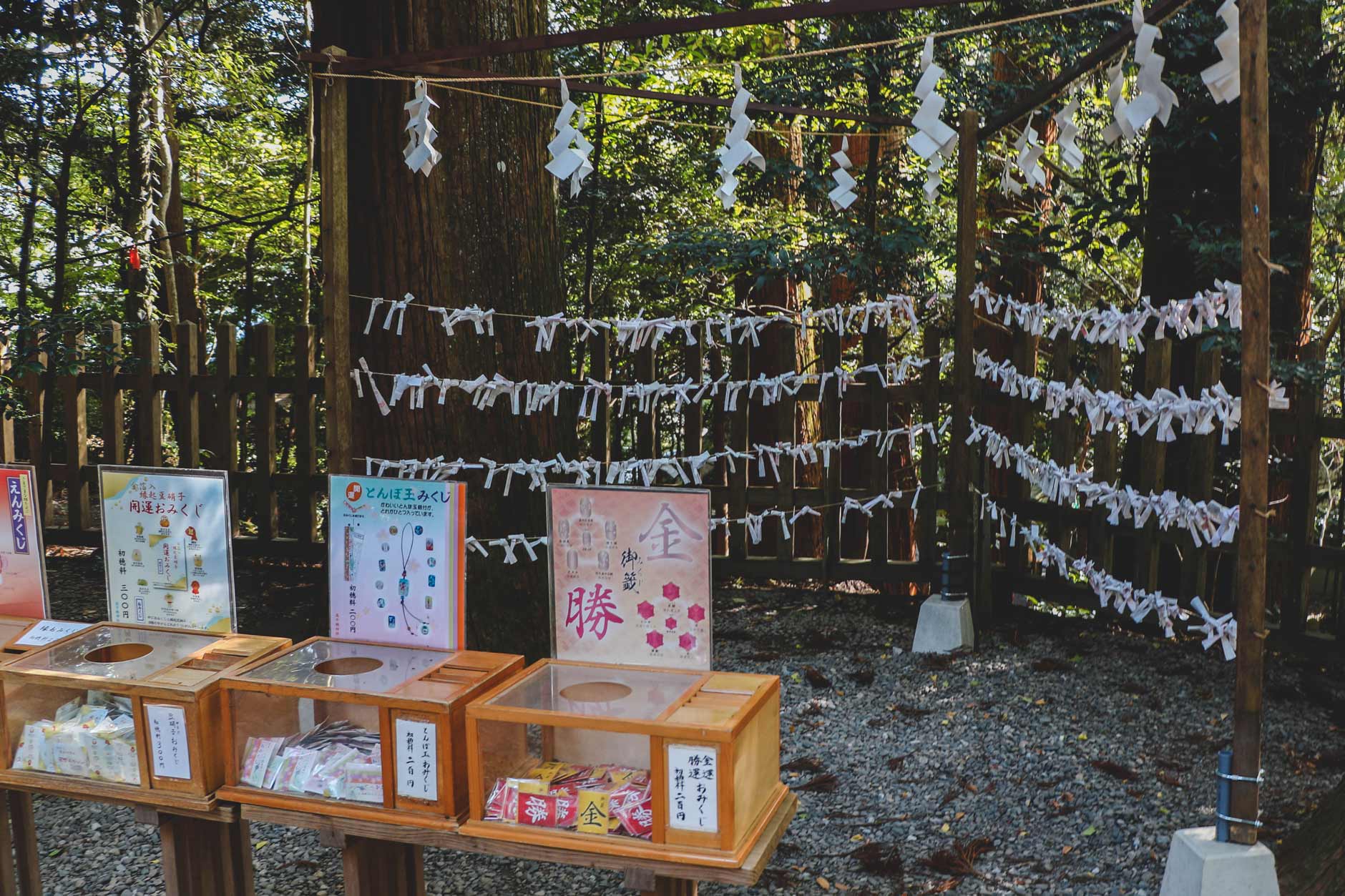
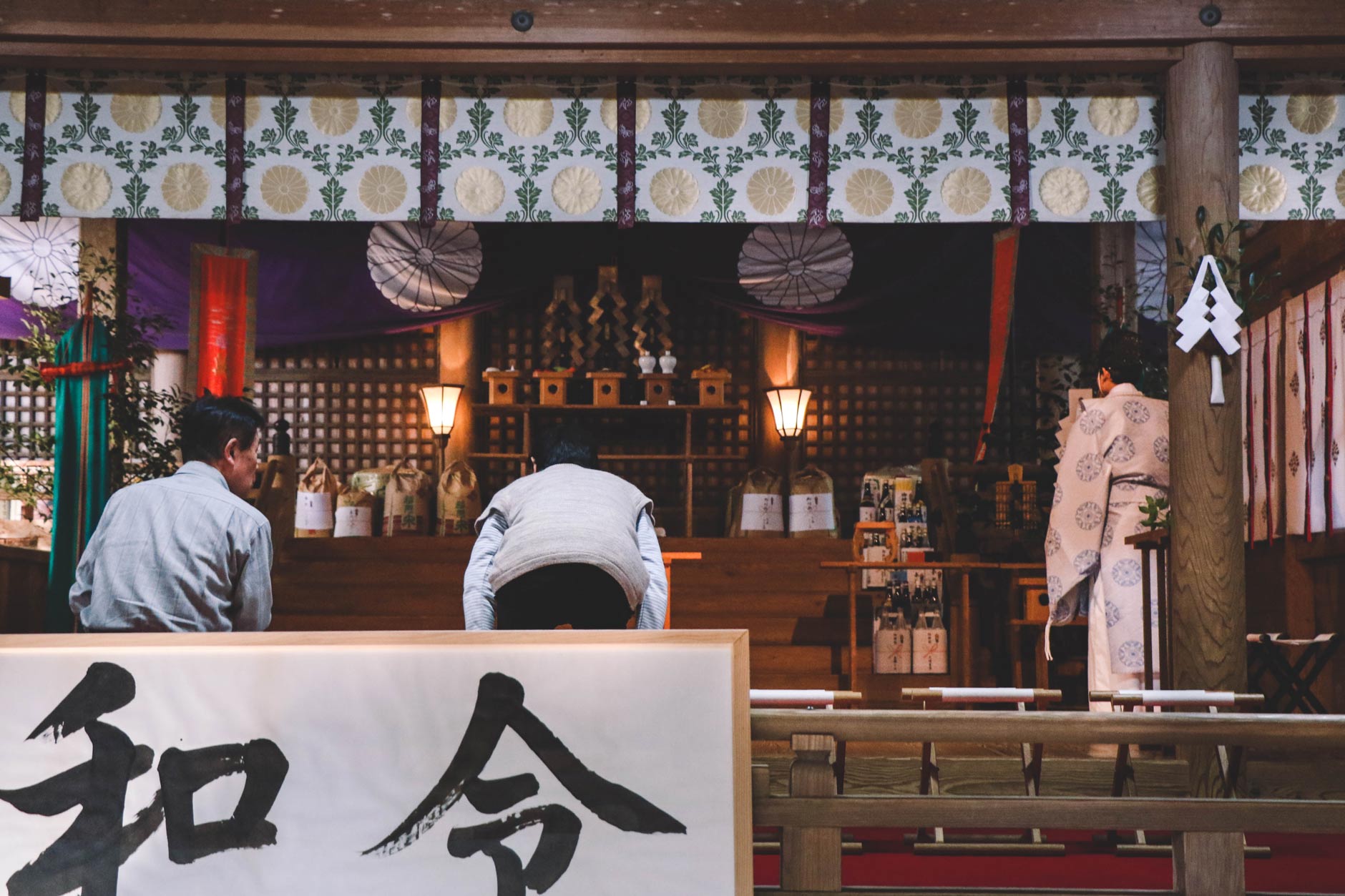
Priest performing traditional ceremony at Takachiho Shrine
Compared to populated Japanese cities, the native religion of Shintoism is alive, intimately interwoven and vibrantly celebrated among the community of Takachiho. It is both awe-inspiring and magical to behold and will illustrate a historical and spiritual side of Japan you may not be able to witness anywhere else.
Things to Do At Takachiho Gorge
Enjoy a Boat Ride Down Takachiho Gorge
hen it comes to enjoying the gorge you can do so in two ways; by foot or by boat. We couldn’t pass up the opportunity to explore the gorge by boat, but had been forewarned that the line for boats attracted a serious crowd with seriously longer wait times.
So, how do you avoid long wait times? You beat the queue and get there first by arriving at 7:30AM. Yes I know, sleep is a hard sacrifice while on holiday, but definitely a worthwhile one. Even though we were first in line, I can tell you that the line started forming only shortly after we arrived and the carpark was almost full when we parked just a bit earlier! It was clear that the late morning starts of the citizens of Tokyo do not apply in Takachiho! Get there early so that you don’t waste large chunks of the day waiting in line. If you’ve only got the day in Takachiho, this will give you time to explore more of the area.
Without an experienced row-boater between us, we jumped in our boat and clumsily fumbled with the oars. The rowing does take some time to get used to, but is a great experience.
As you row down the gorge, you can get up close and personal with the Manai falls – even rowing under it if you like – and also take a closer look at the colonnade structures of the gorge’s walls. It can be scary at times as a rookie rower – wall and boat collisions will and do happen, but the boats are sturdy enough that it makes it difficult to fall in. I don’t know what happens if you do fall in, or what, if anything, lurks beyond the depths of the Gosake river, but you are equipped with a life vest ensuring safety no matter what happens.
There is a time limit of 30minutes per boat ride – which actually goes pretty fast! You can also buy some food to feed the ducks, which we did! Rowing down the gorge and back, plus feeding the ducks, actually took us a little longer than 30 minutes, but the staff were really nice and didn’t charge us extra.
It costs 2000 yen to hire a boat and each boat can fit a maximum of 3 passengers. Boats cannot be pre-booked. Food for the ducks costs 200 yen. There are no facilities to hold your luggage, so leave it in your hotel, car or tour bus!
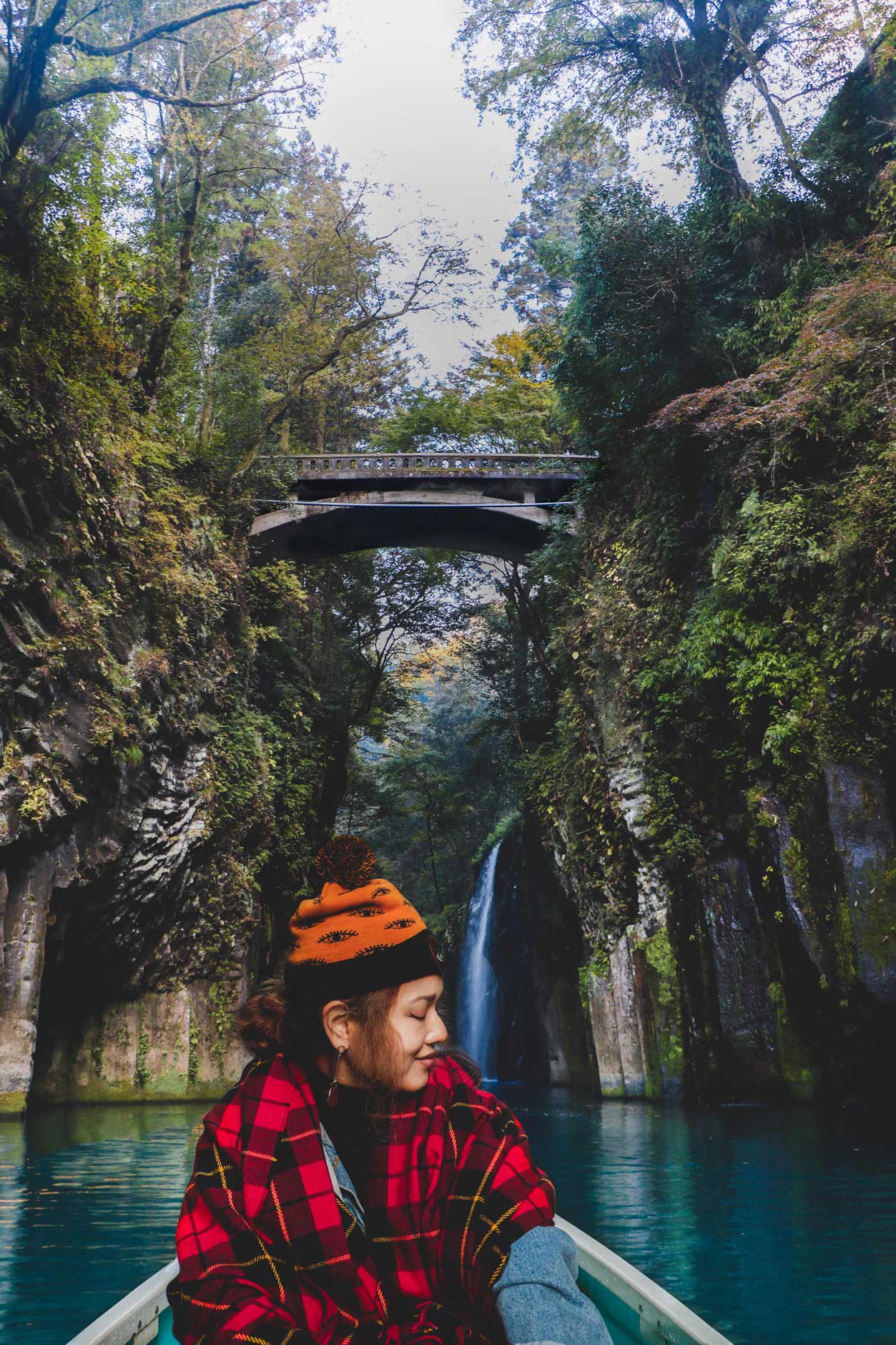
Looking at the picture above and to the right, you can see the collonade structures of the Gorge’s walls.
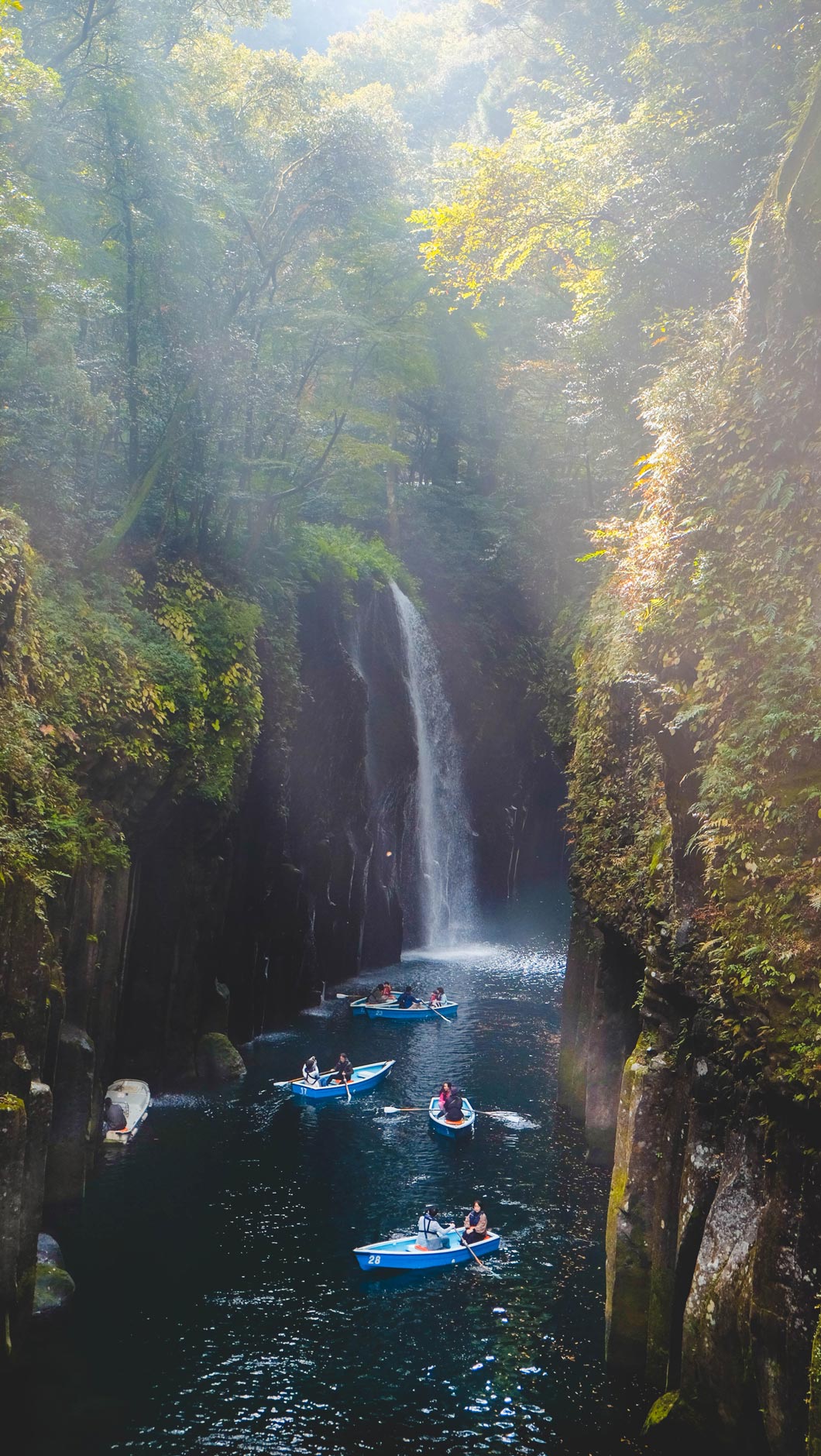
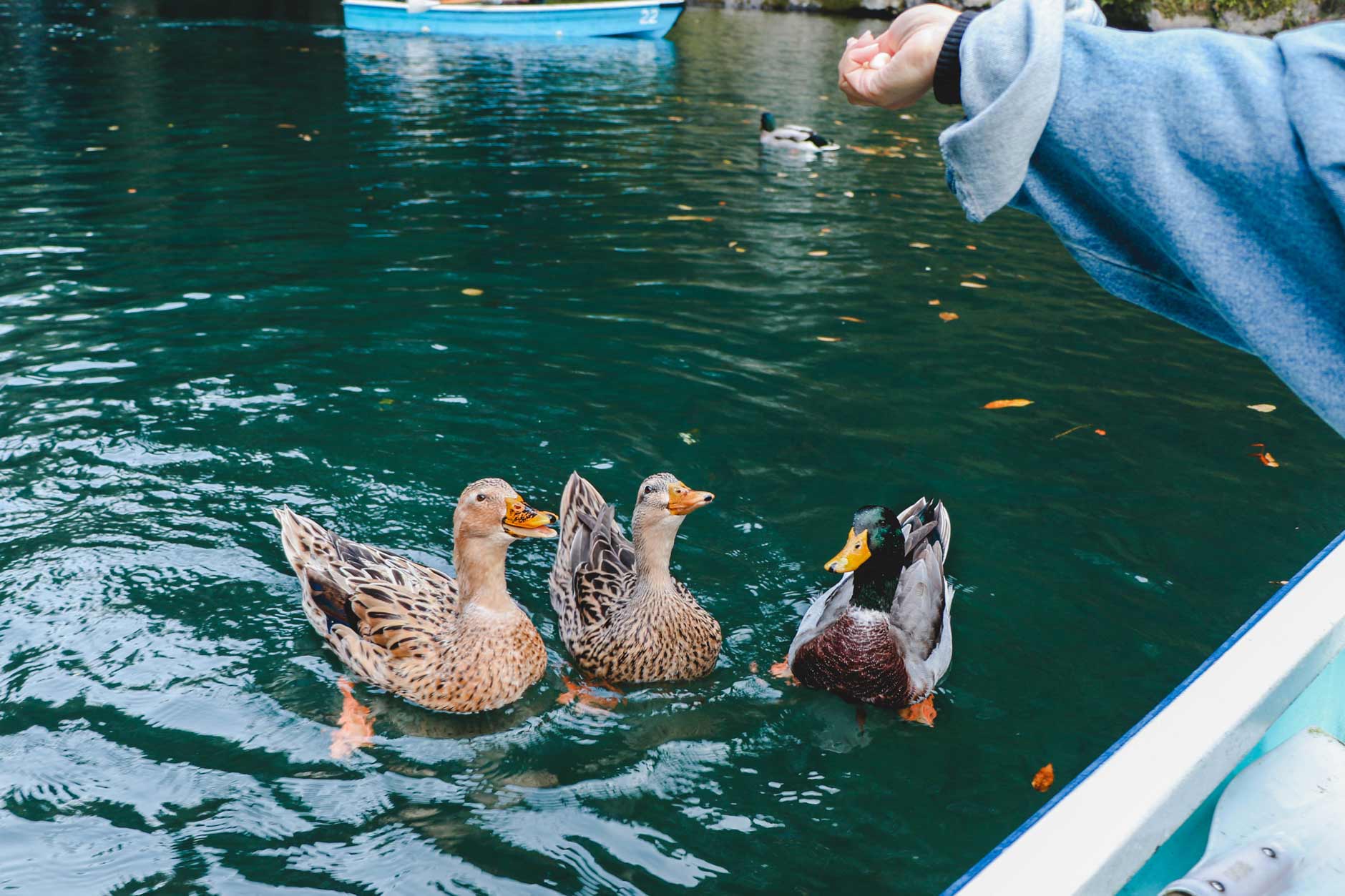
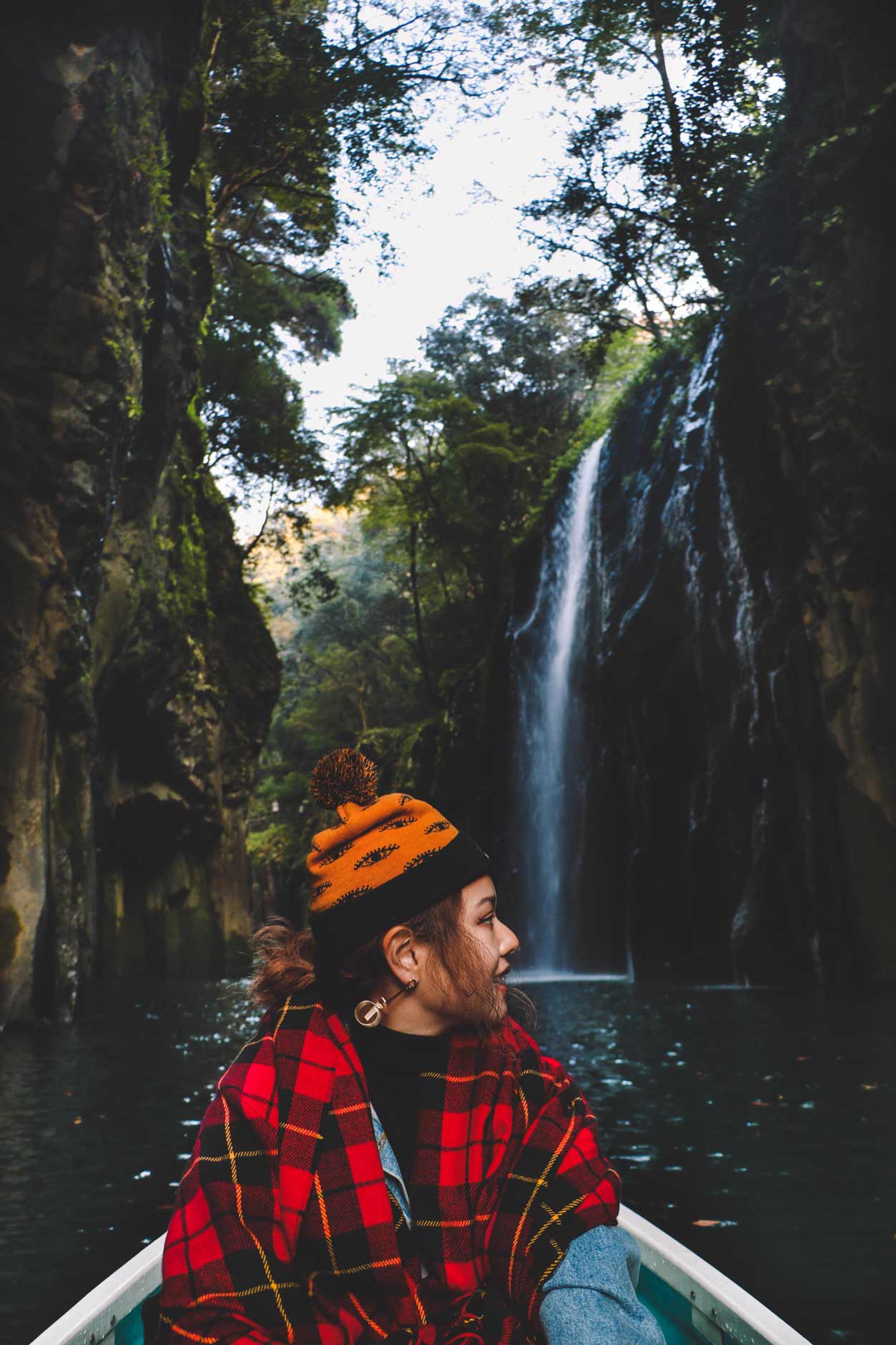
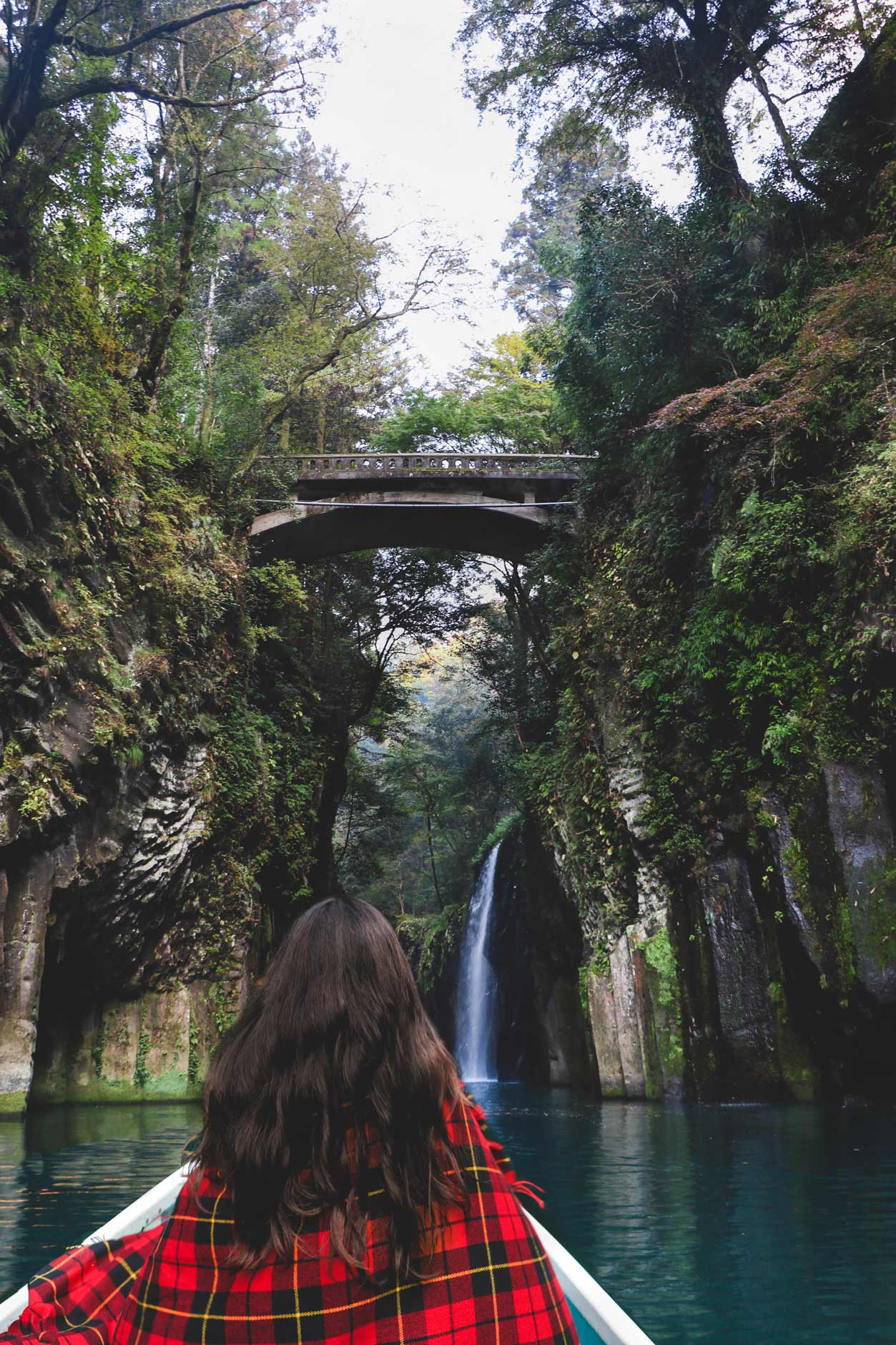
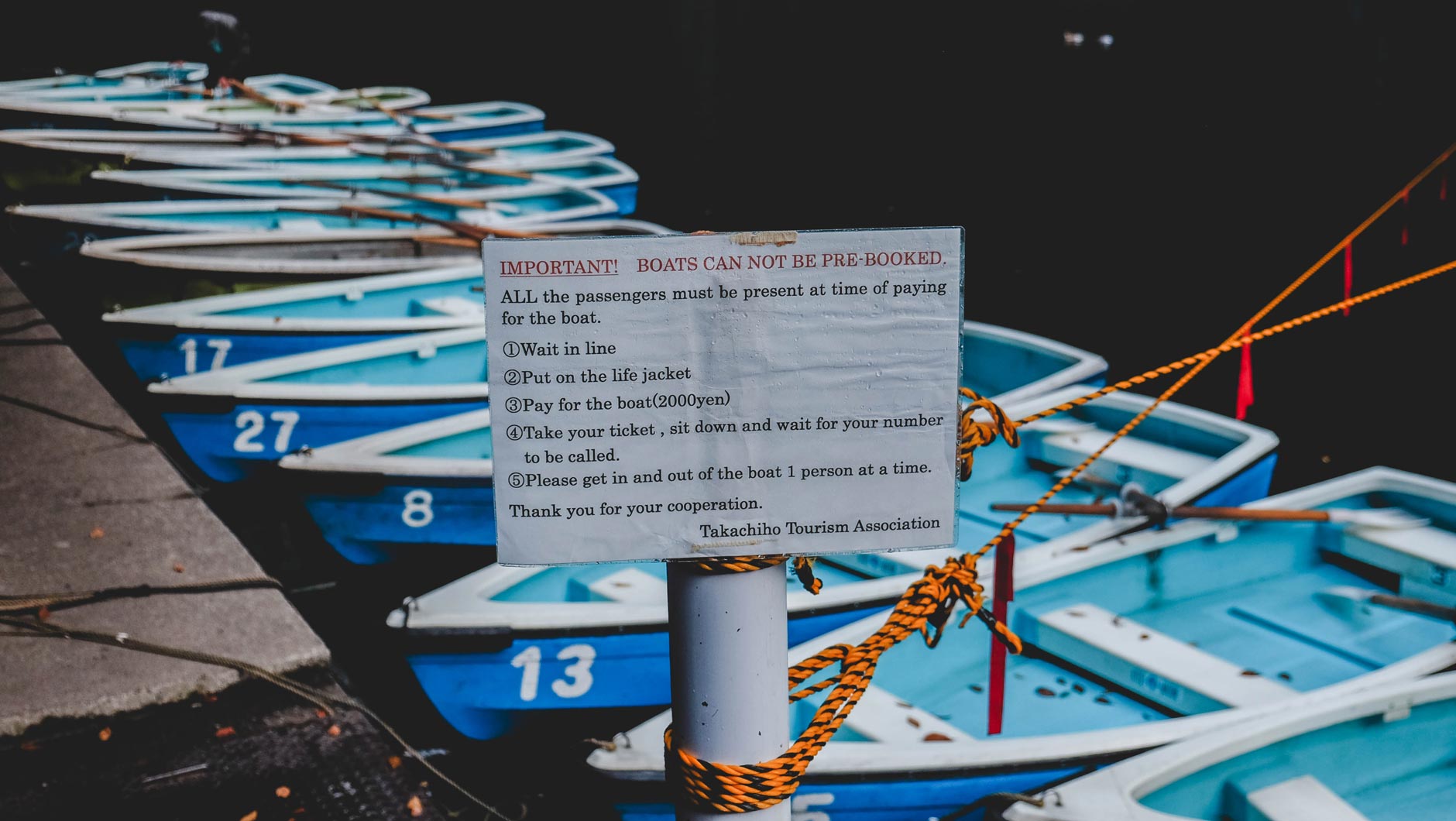
Takachiho boat ride rules.
Walk Along Takachiho Promenade
f roughing the waters of the gorge is too much for you, you can also enjoy the scenic beauty of the area from above by following the paved pathway that follows the edge of the gorge. The path offers stunning views all along, with some perfect postcard photo opportunities of the gorge and Manai falls.
Stroll the path for as long as you like, taking time to observe down into the gorge from the various bridges and viewpoints to get some really nice photos. It is along this walk that you’ll get the popular shots you see online of looking down into the gorge through a canopy of momiji leaves as well great viewpoints of Manai falls with boaters below. Continue walking and eventually you’ll arrive at Takachiho Shrine. The total length of the trail is about 1km (10mins).
Visiting in autumn we were expecting yellow and orange momiji leaves, but the leaves change colour here later than the rest of Japan – so keep that in mind if you’re hoping to catch autumn surroundings during your time at the gorge.
With that being said, summer’s green leaves are also delightful and the greenery enhances the gorge’s mystical atmosphere. In summer, the gorge is also illuminated in the evenings until 10PM.
Along the walk there are numerous points of interest such as Kihachi Rock – a 200 tonne rock said to be thrown by the god Kihachi as he challenged the irresponsible deity that ruled the village of Takachiho and Onokoro pond.
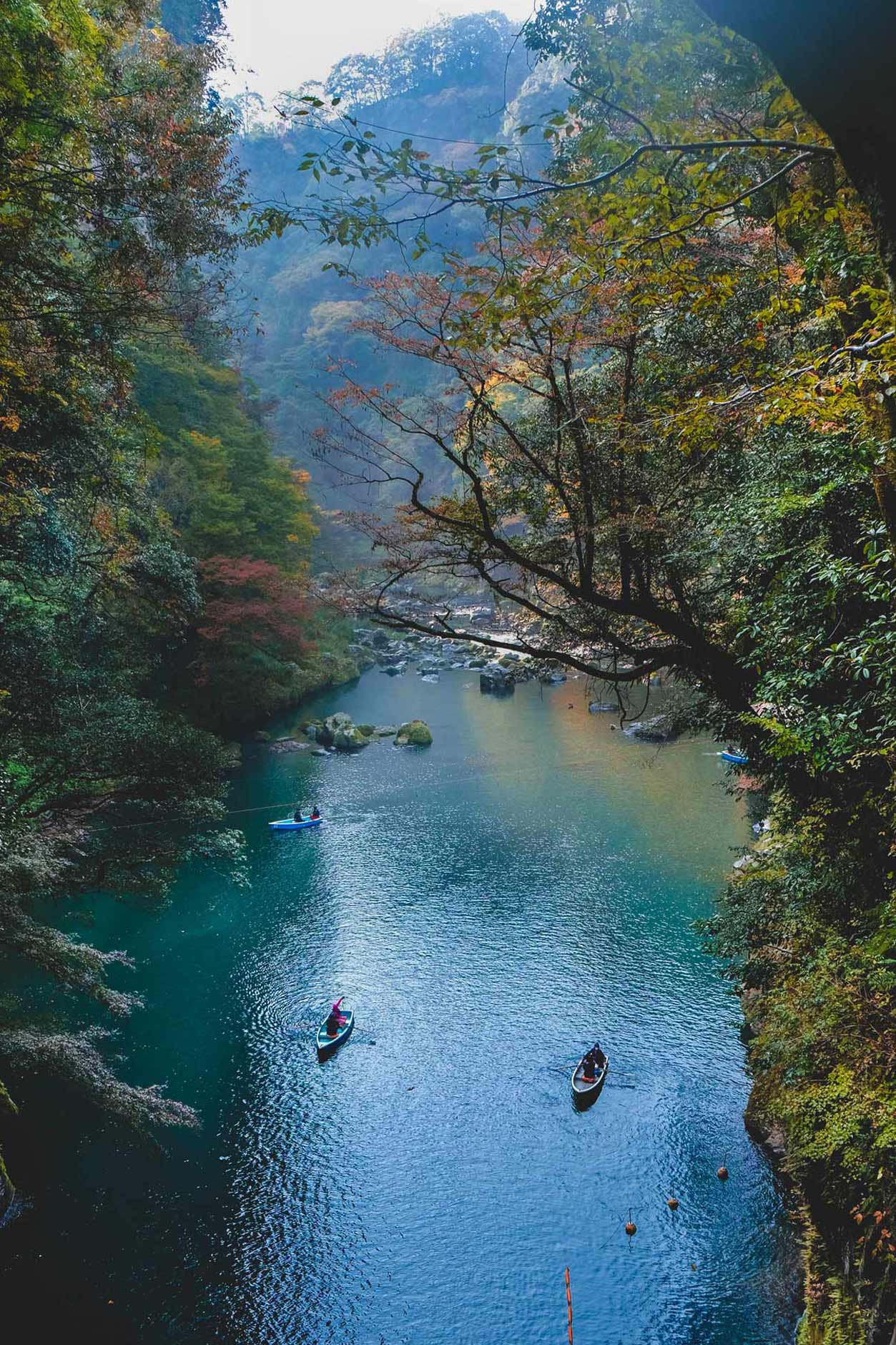
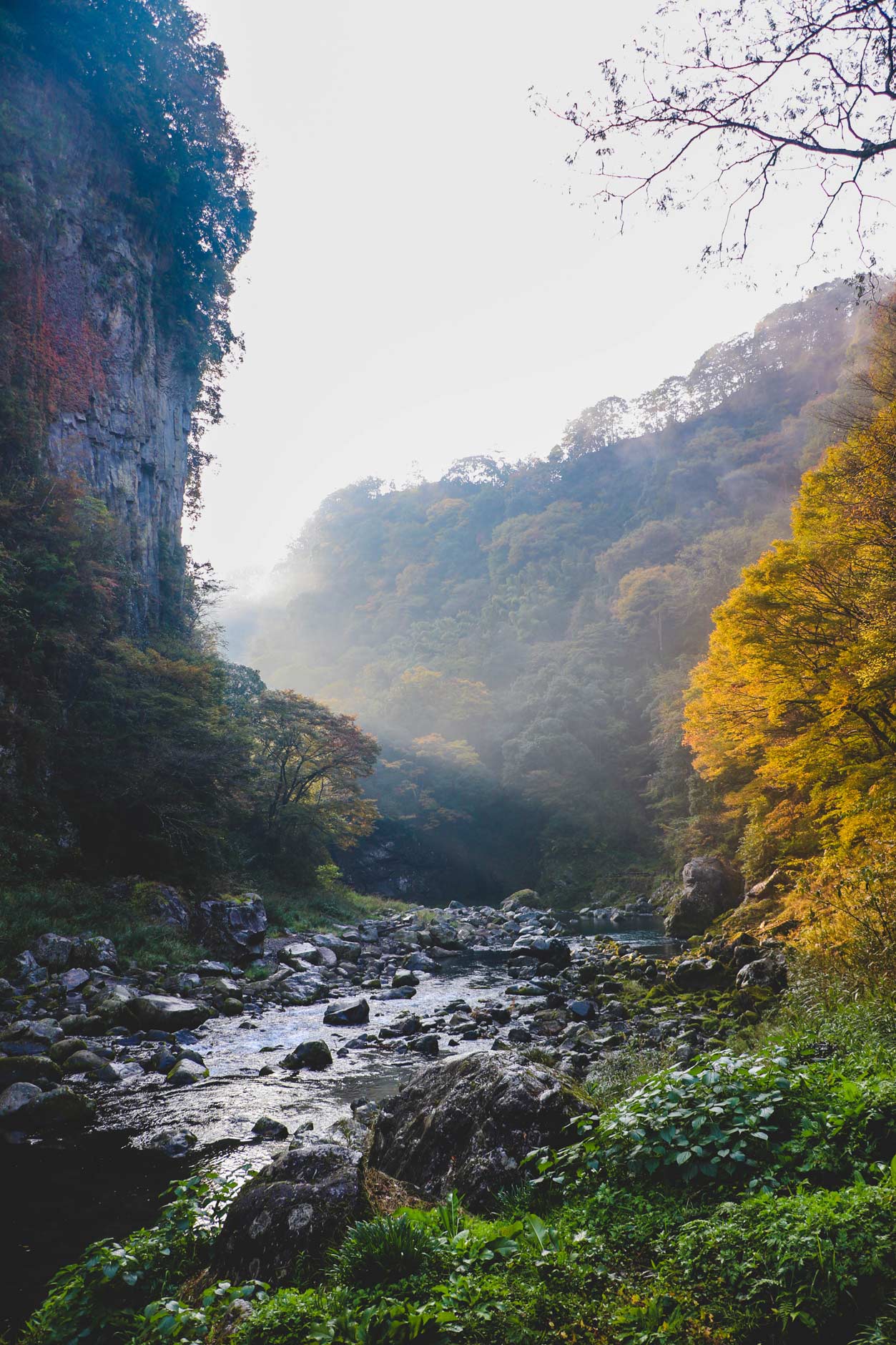
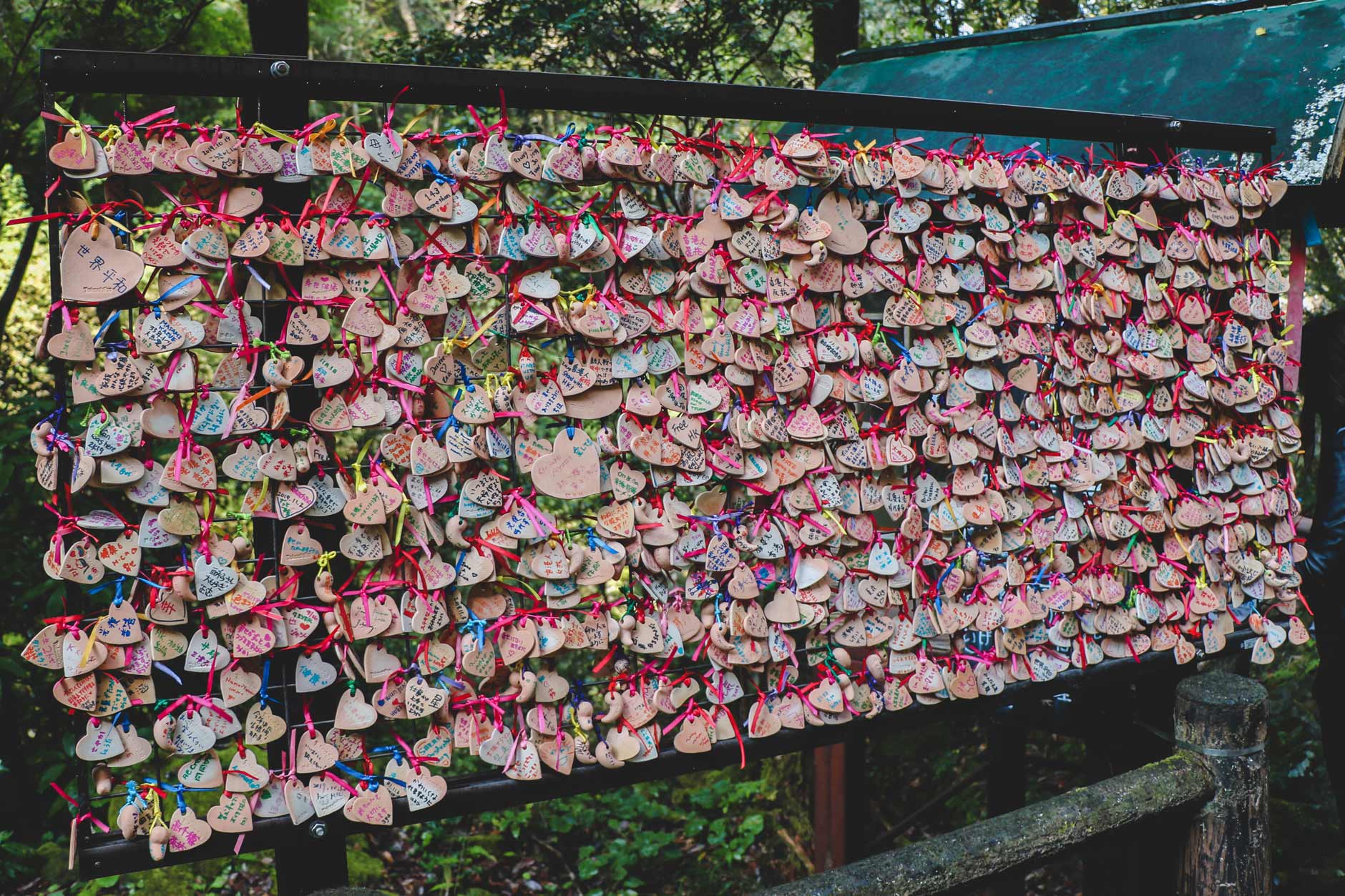
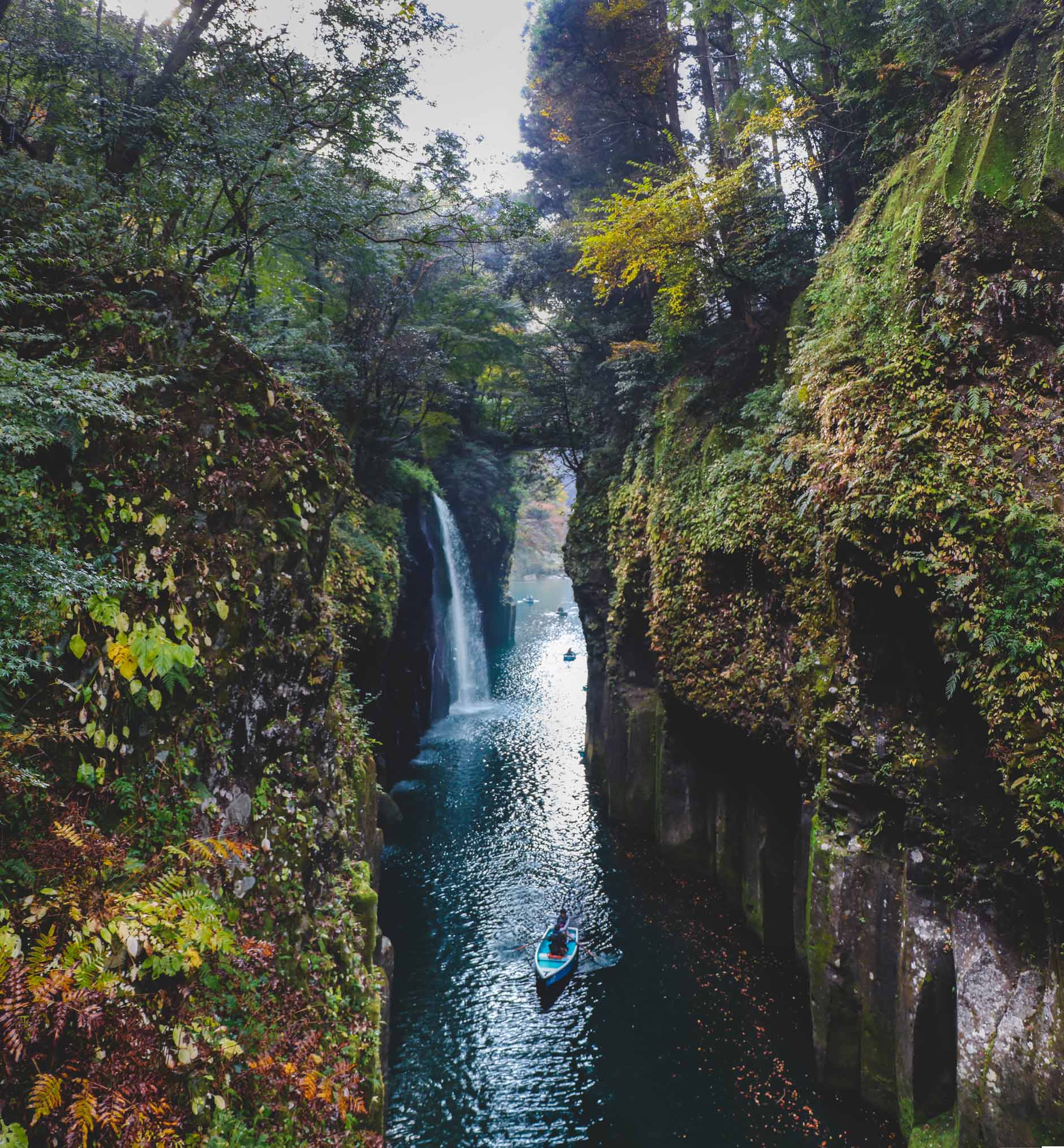
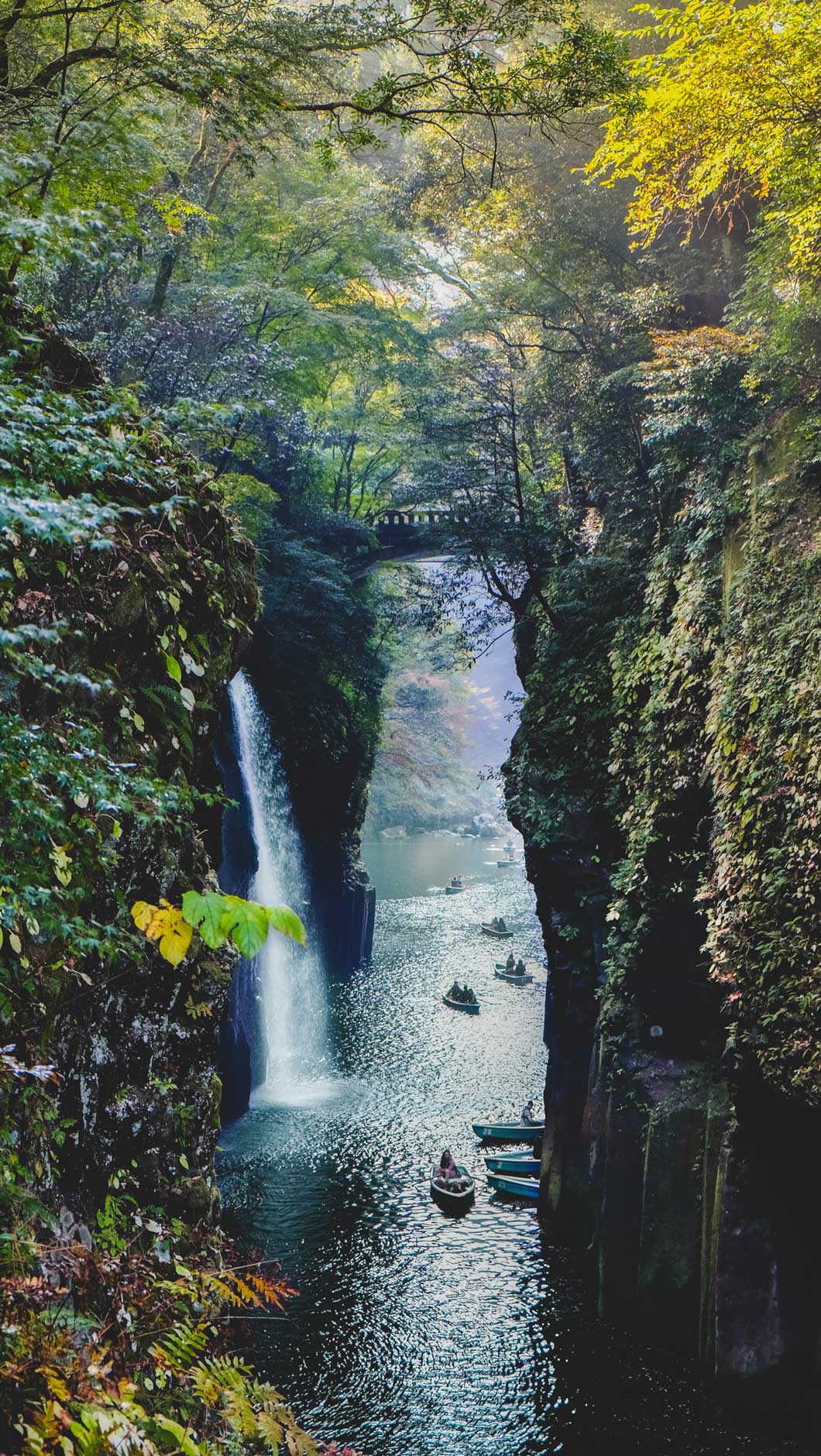
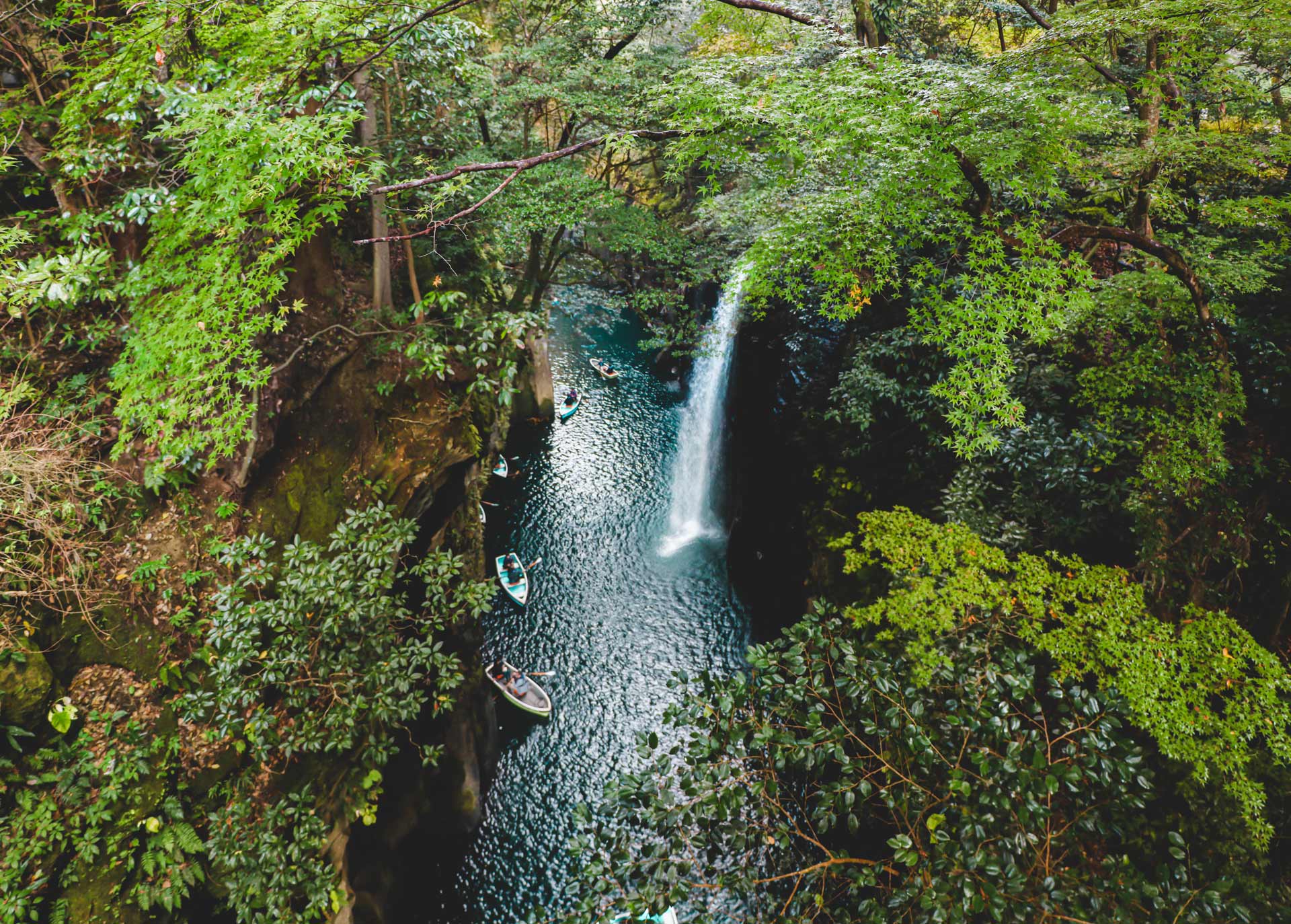
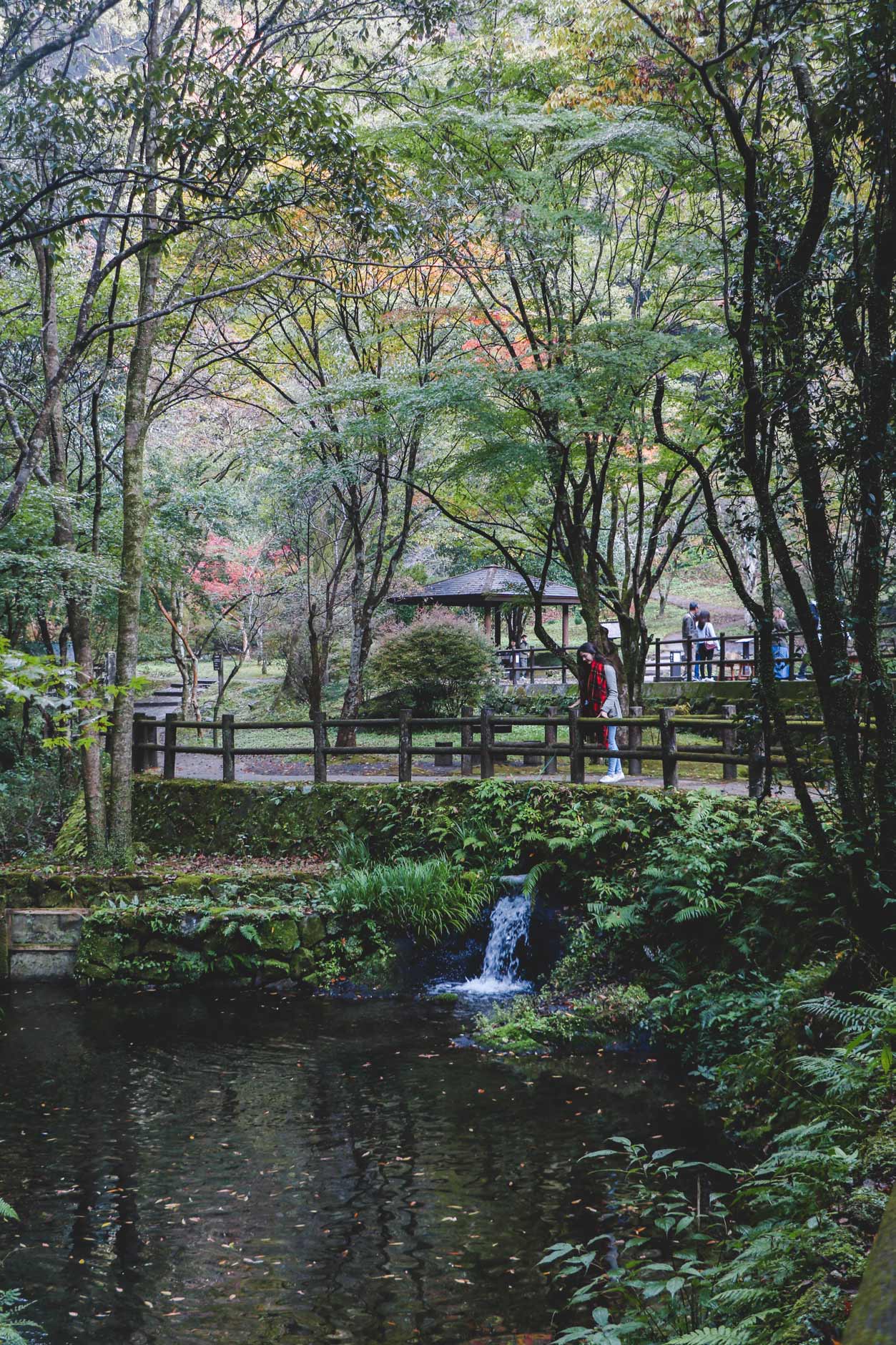
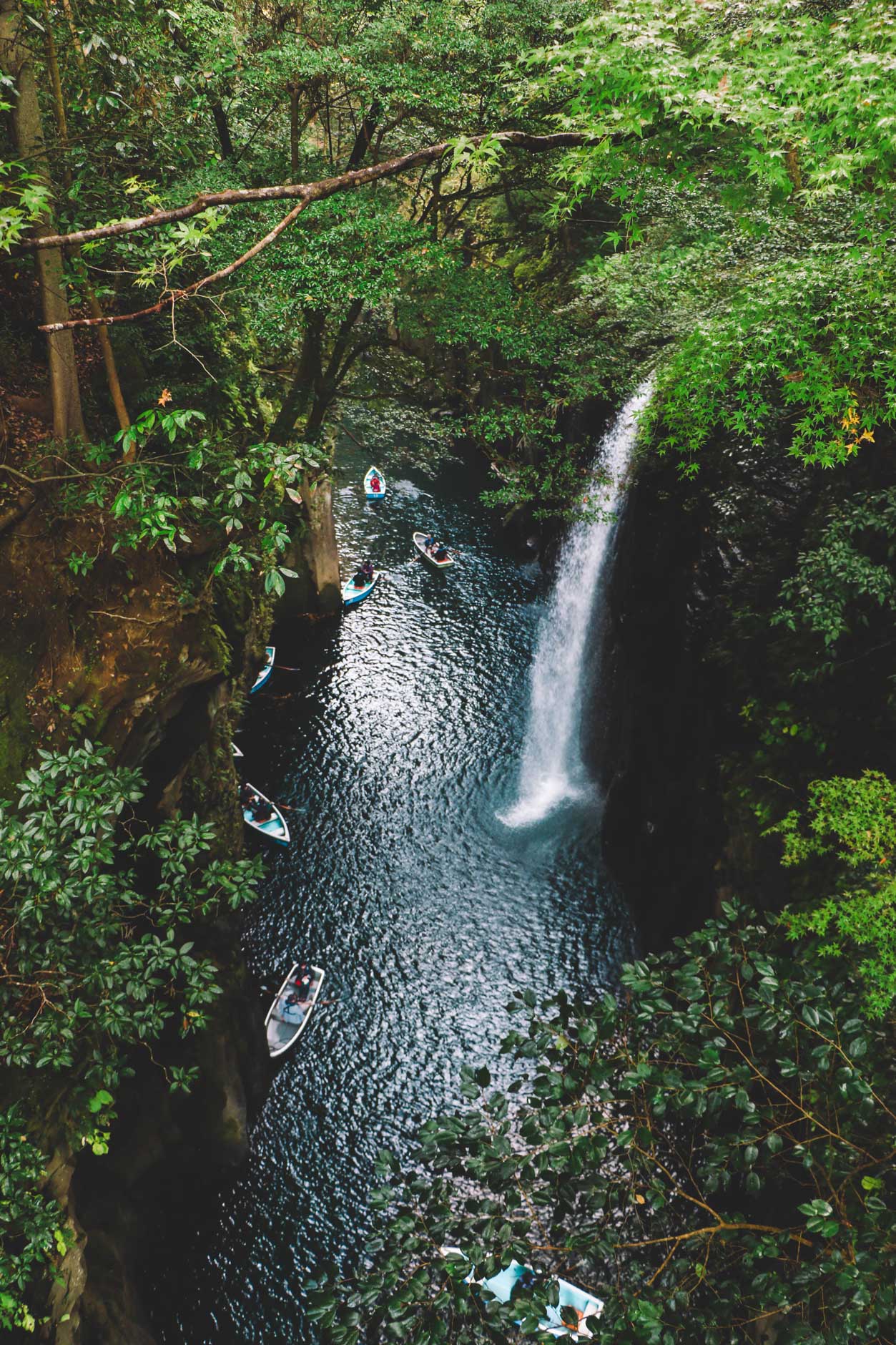
Take a Gander at Onokoro Pond
f I’m being fair, I can’t say that this pond is anything special to look at (sorry!) but it’s cultural significance is one that may tickle your fancy.
In the centre of this pond is a small island with a little shrine (known as onokorojima).
With Takachiho’s close association to Japan’s creation myths, it is said that this is the first Japanese island that the gods Izanagi and Izanami created. Because of its historical significance, each year during the spring festival of Takachiho shrine, a portable shrine circles around onokorojima three times – a ritual purification known as misogi.
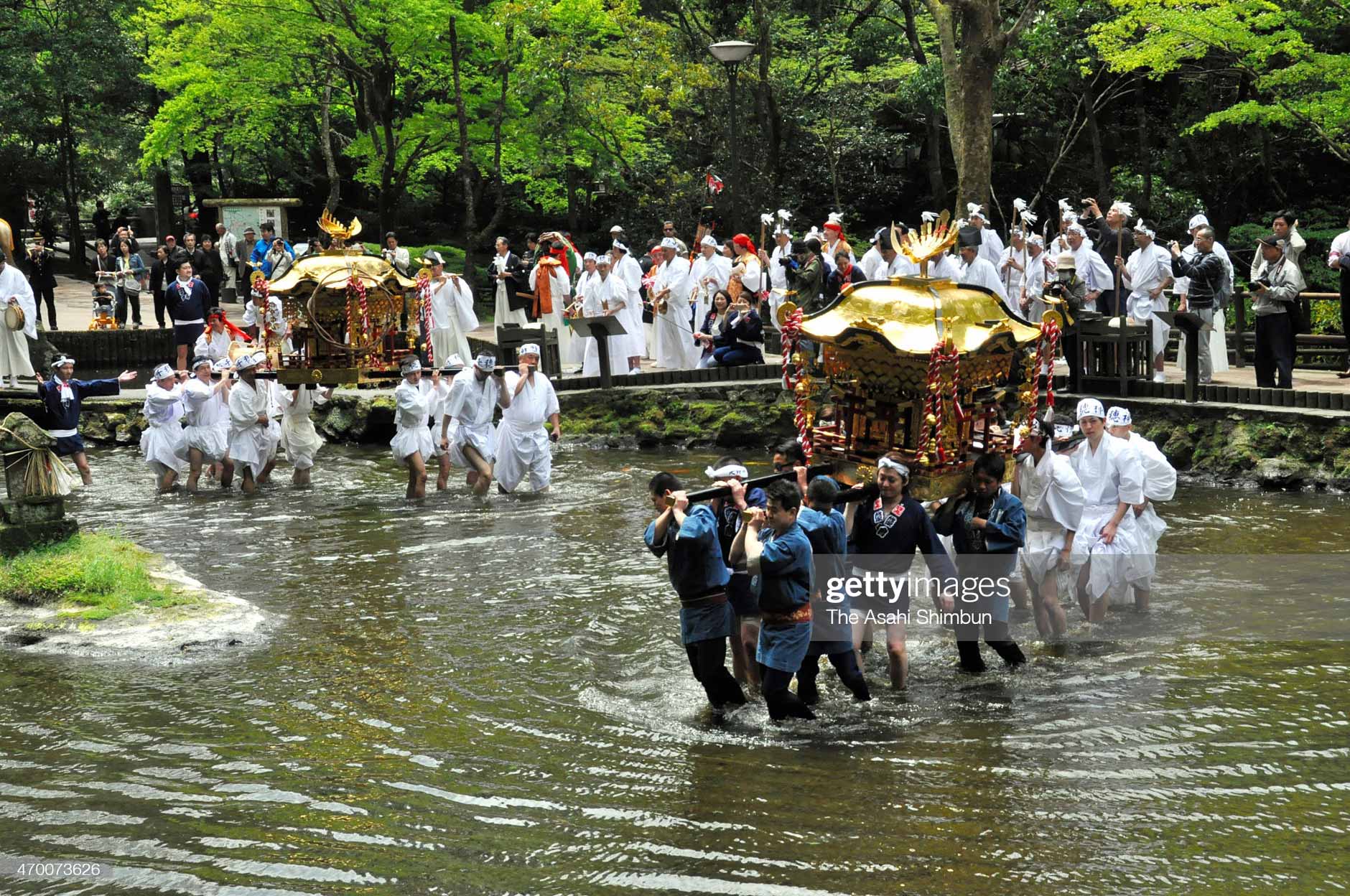
Spring Festival celebrations in Onokoro Pond, Takachiho. Taken from Getty Images
Catch the Sunrise above a Sea of Clouds at Kunimigaoka
f you thought Takachiho wasn’t pretty enough, just wait until you visit Kunimigaoka (Country Gazing Hill) look out. Located a short drive up the mountain from Takachiho Gorge, this beautiful view overlooking the Takachiho countryside awaits. It’s stunning even during daytime, but the magic really comes alive at sunrise where a phenomenon known as ‘unkai ‘occurs between the months of September – late November.
Unkai translates into “Sea of clouds” and on days where there is a significant difference between the minimum and maximum temperatures, the beautiful Japanese fog and mist creates a sea of clouds that covers the entire valley. It literally looks like as if you are standing above the clouds. Definitely worth the early morning start.
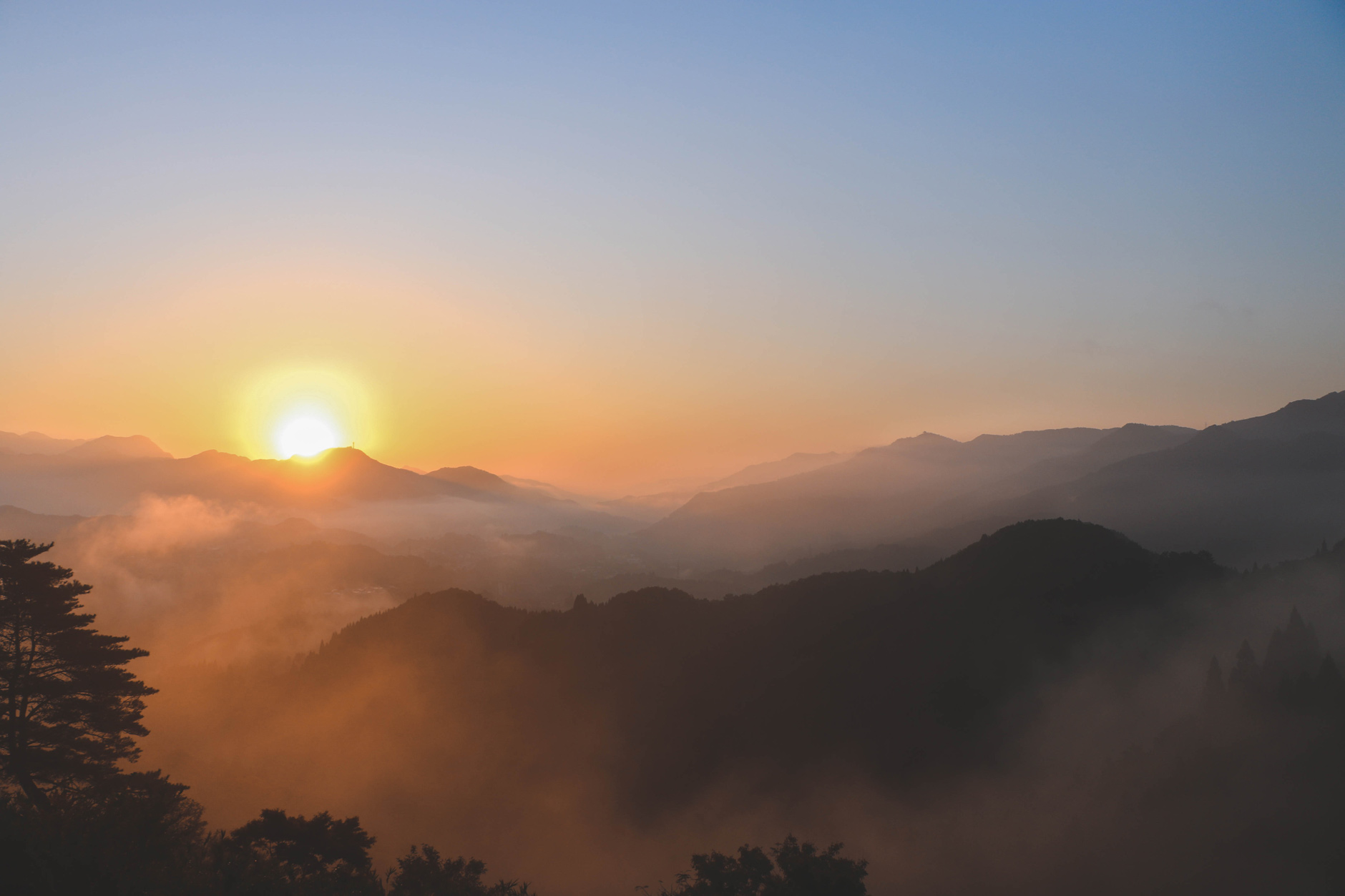
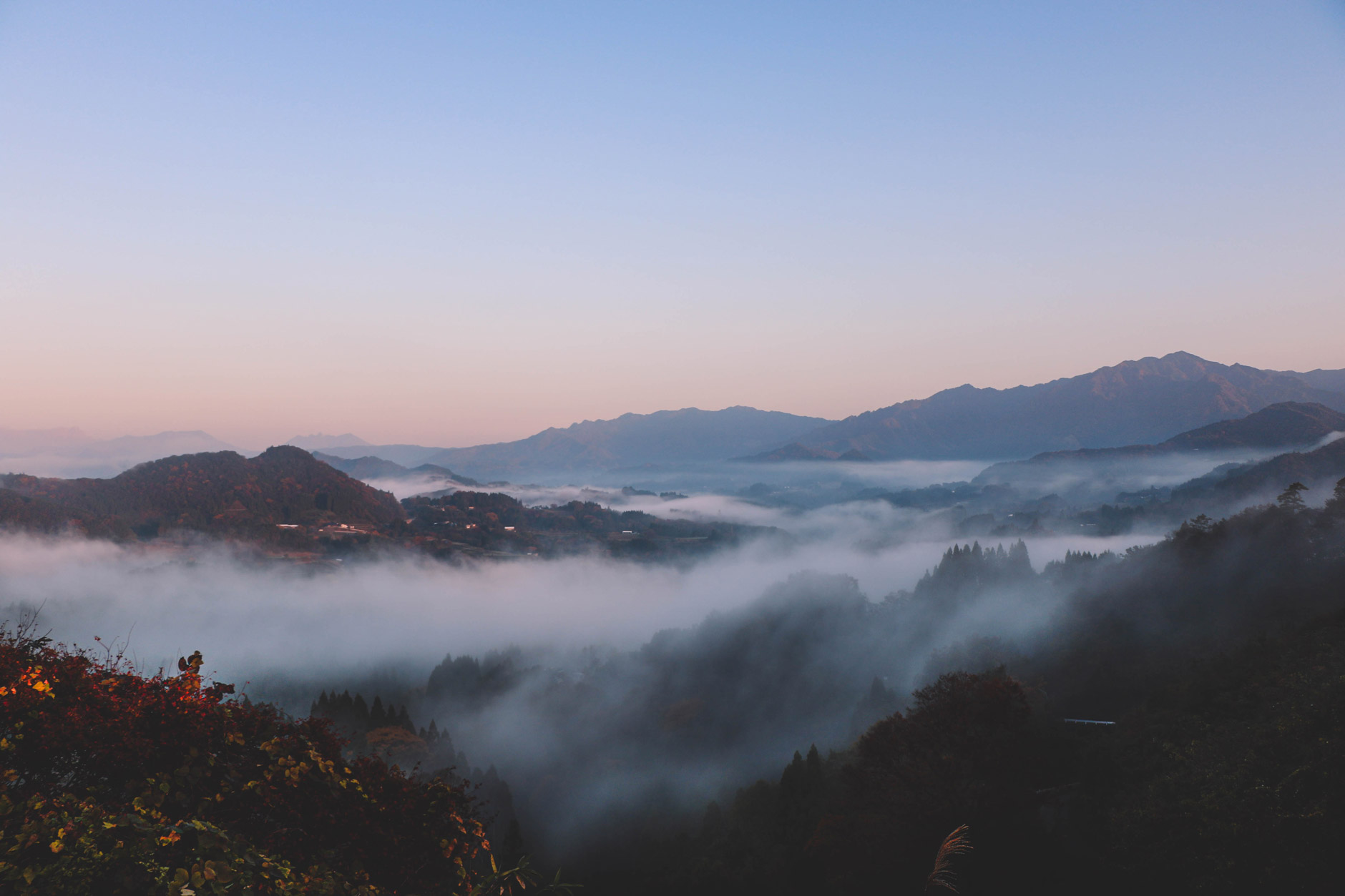
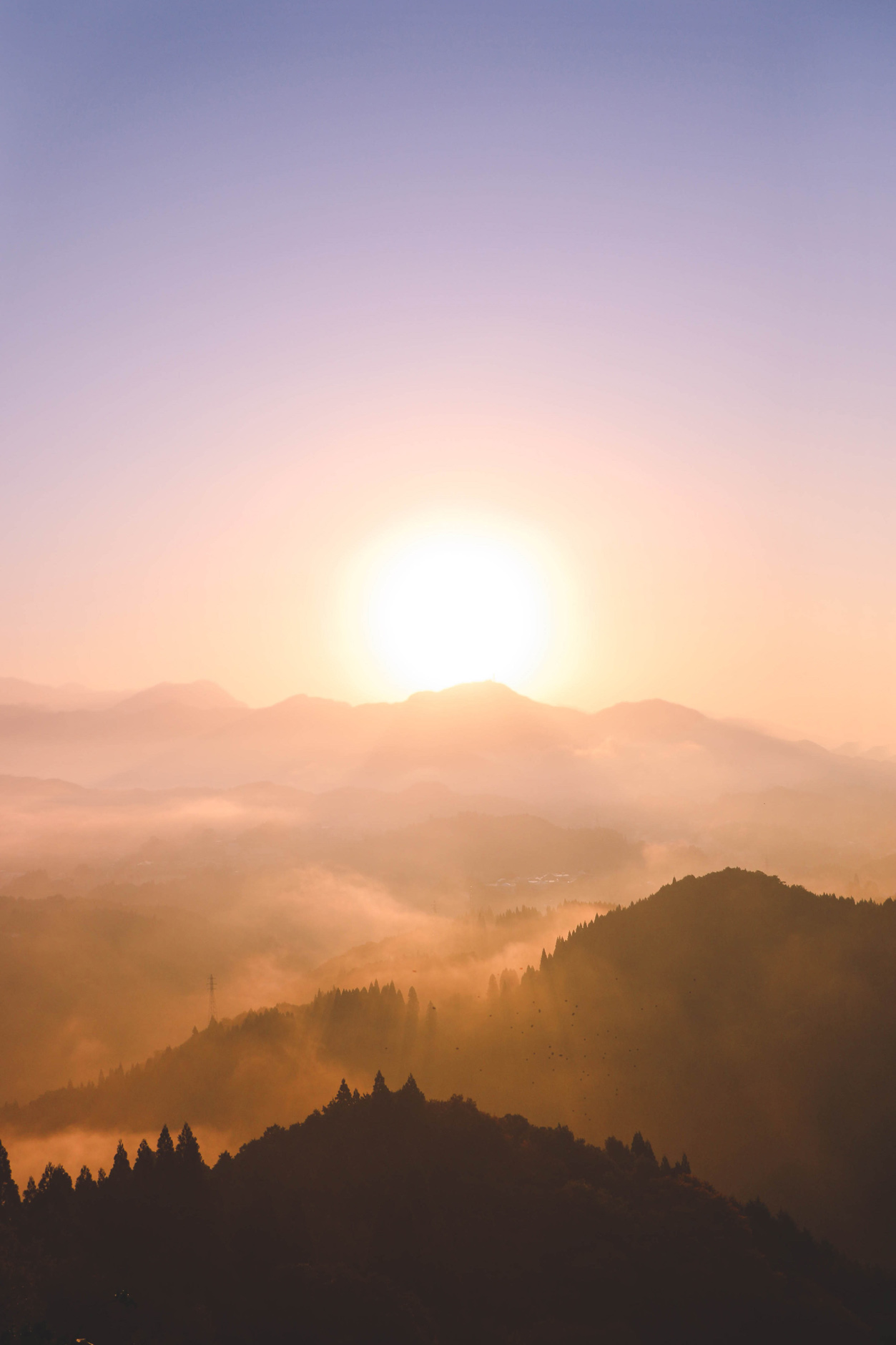
Watch a Traditional Kagura Performance at Takachiho Shrine
agura is Japan’s earliest form of religious dance with deep ties to Shintoism. It is thought to have entertained the imperial courts and general public for over 1000 years.
Kagura reenacts the stories from classical Japanese mythology. Over time as the country lost touch with Shintoism the tradition wasn’t passed down through the generations, and today, it is really rare to see Kagura performed in urban areas. In fact, there are only 5 places in Japan that perform traditional Kagura regularly and Takachiho is one of them.
There are two ways you can engage in Kagura performances in Takachiho. The first is nightly Kagura Performances at Takachiho shrine – a shortened 4 act version of the 33 acts in Kagura.
The second is the all night Takachiho Yokagura Festival held on the 22nd and 23rd of November. For the entire night, the Takachiho community comes together to enjoy Kagura dancing, storytelling and local foods. At this festival, the full 33 acts of Kagura are reenacted across the entire night. Fascinated? Us too. Find out more about Kagura in Takachiho in our Blog Post: “See a Traditional Kagura Show in Takachiho”
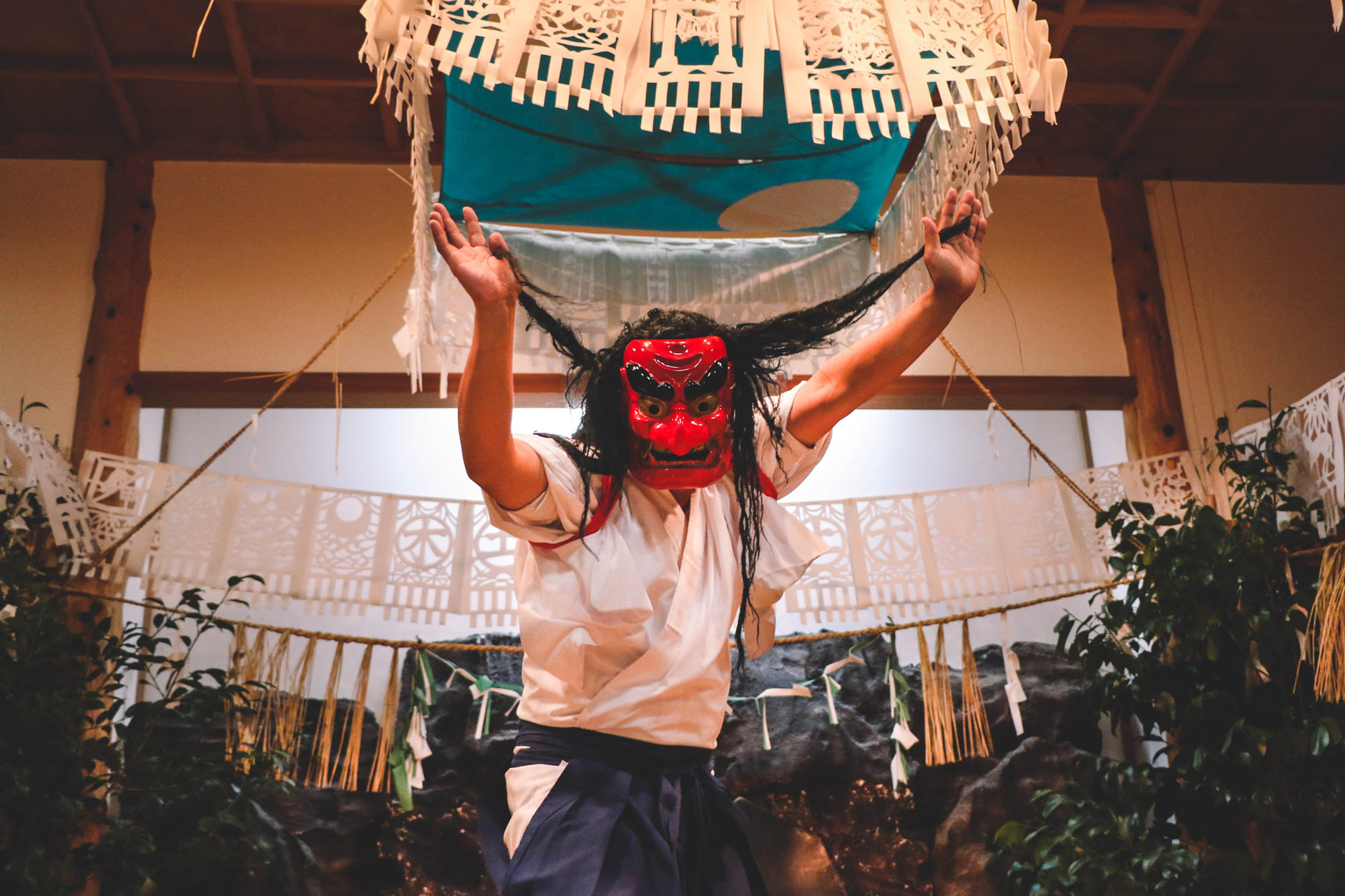
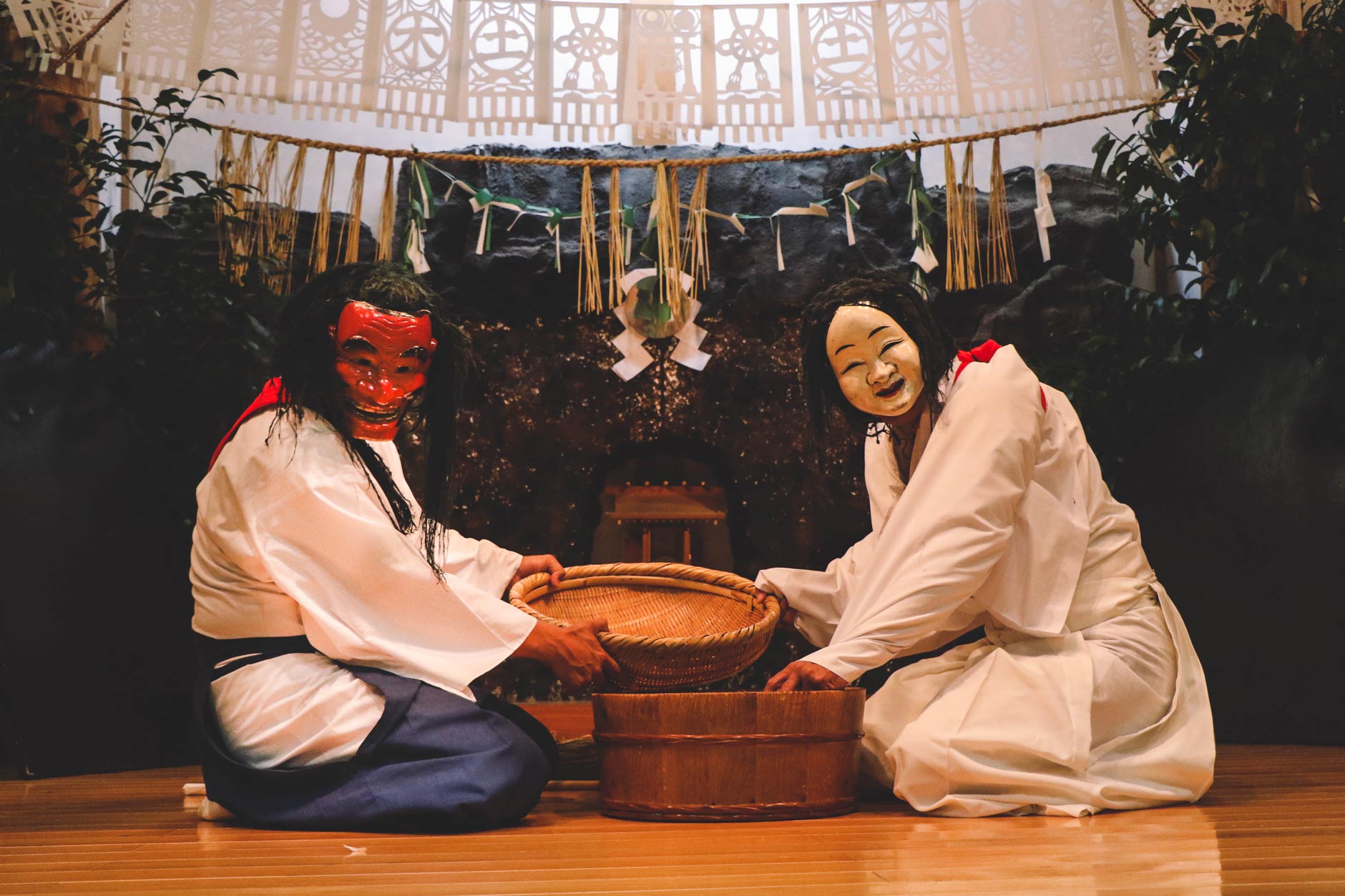
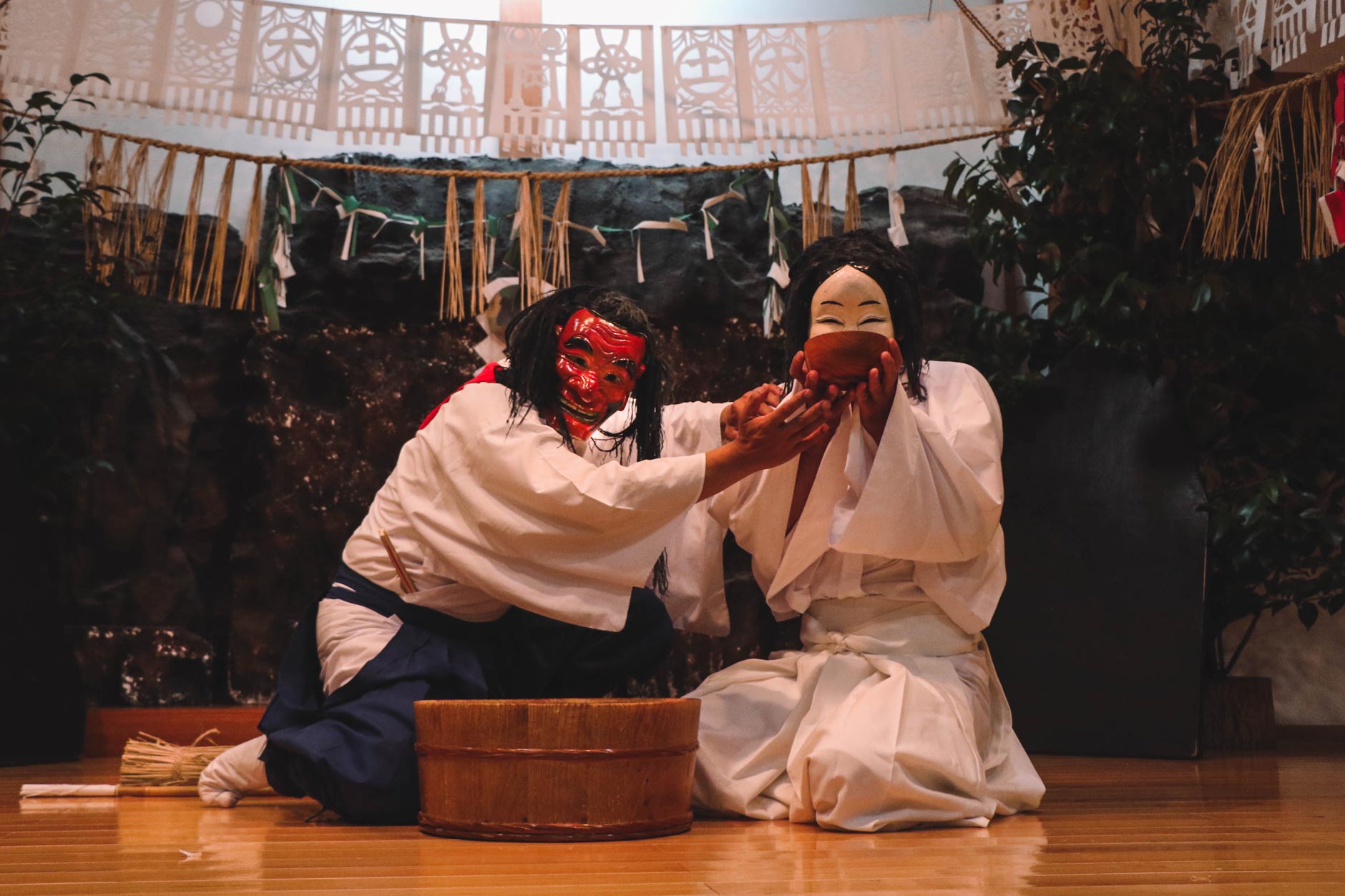
What to Eat
hiho No Ie is a restaurant located at the heart of Takachiho Gorge that specialises in Nagashi Soumen or flowing noodles. How it works is somen noodles (thin white noodles, similar to soba) are dropped into a bamboo stalk cut in half to form a “chute” that is filled with flowing water. As the somen flows down the chute, you try to catch them with your chopsticks. These noodles are cold and like Soba, somen noodles are dipped in a dipping sauce before being eaten.
I don’t know about you, but there’s always one episode in an anime series where the school class goes on some summer holiday and one of the many activities they do is eat Nagashi Soumen – so i’ve always wanted to do it!
Despite being autumn, we could still enjoy the fun! It was especially cool to experience it for the first time in Takachiho, as it is thought the origins of the dish may lie here! Established in 1955, Chiho no Ie claims to be the birthplace of Nagashi soumen and still streams cool, fresh water from Tamadare Falls, as thought to be originally done.
We also ordered the hot beef soba noodles (absolutely delicious!) as well as the somen set meal with grilled fish. All very fresh, tasty and unique with foods I’d never had before.
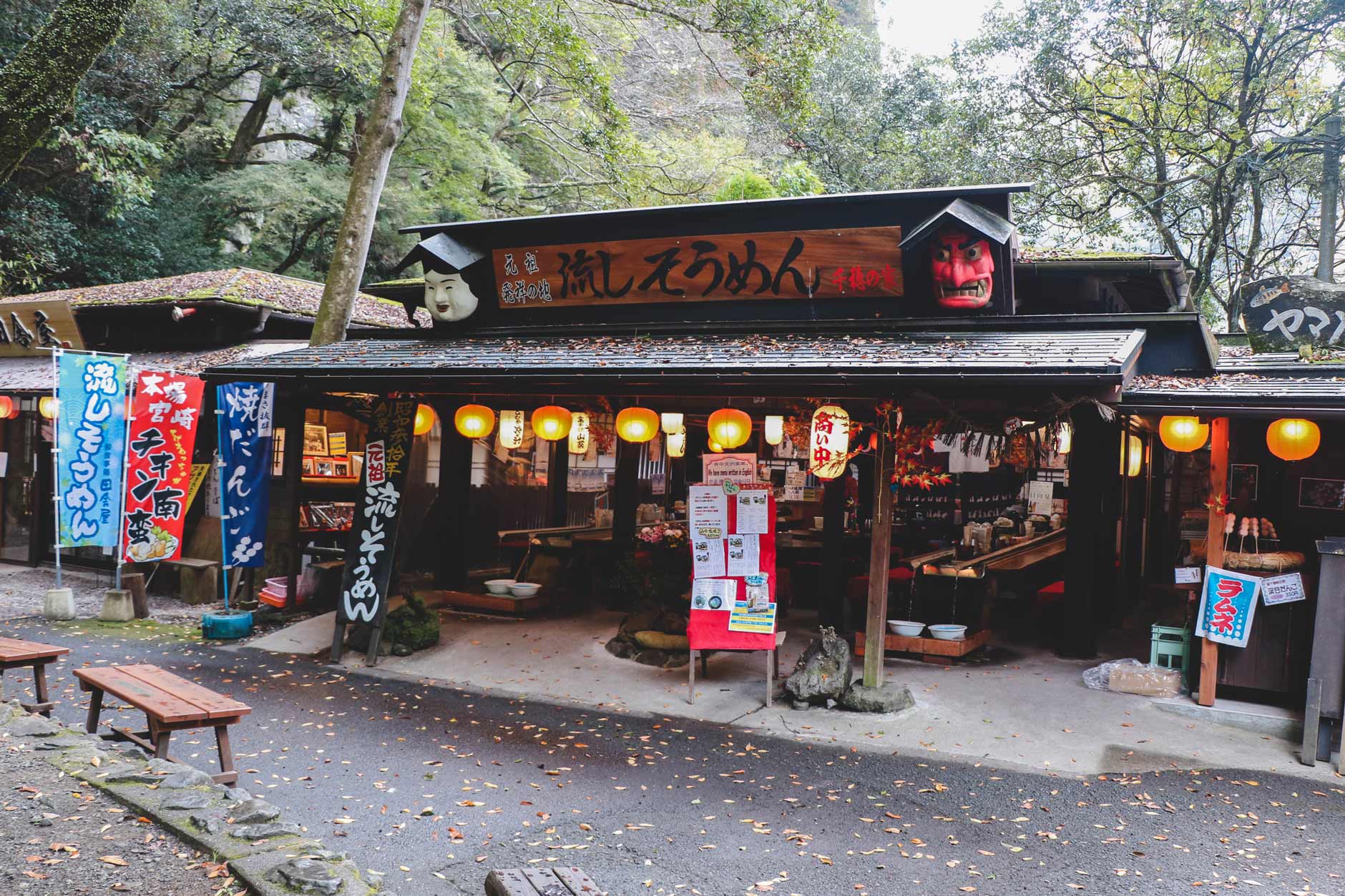
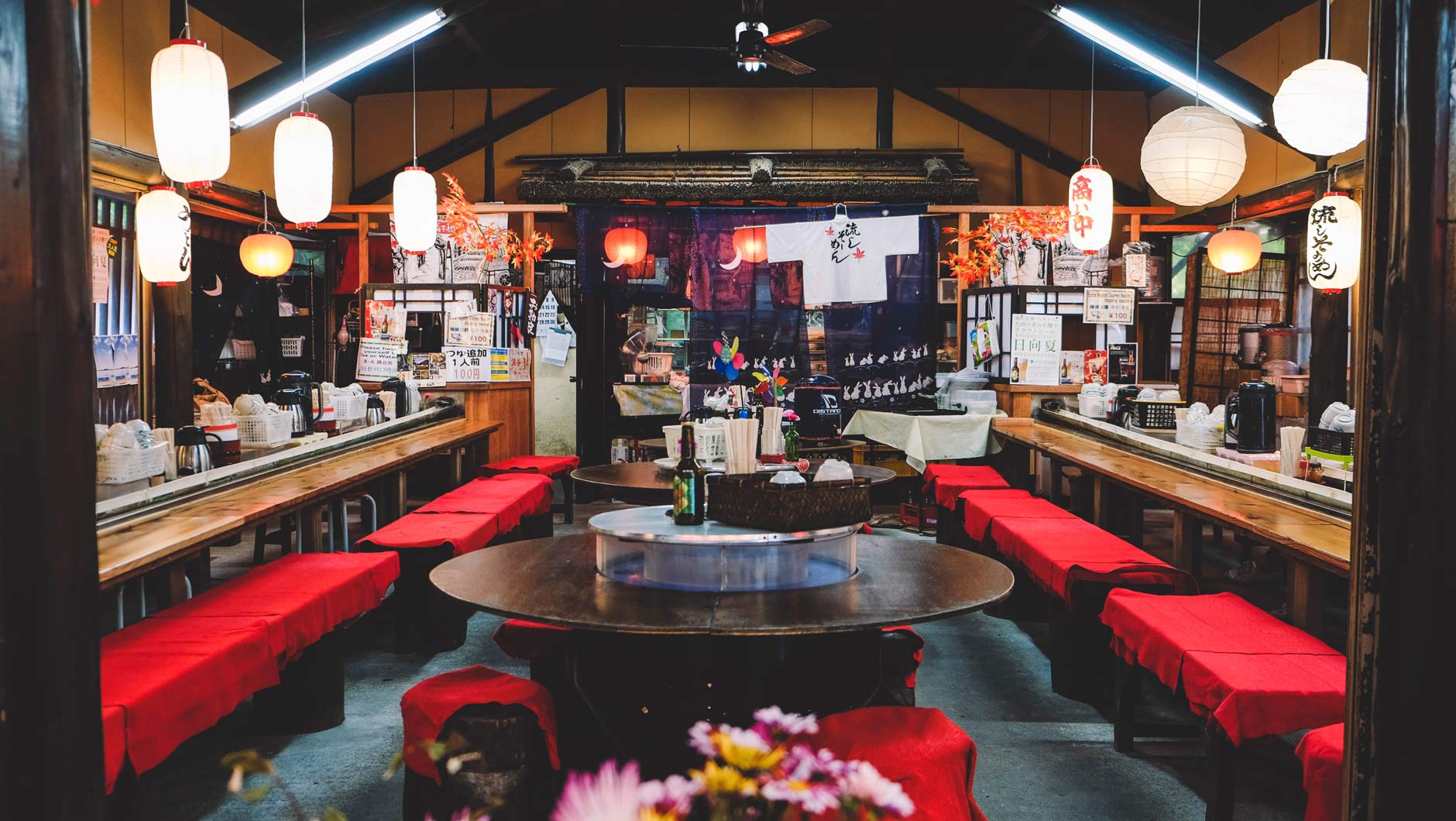
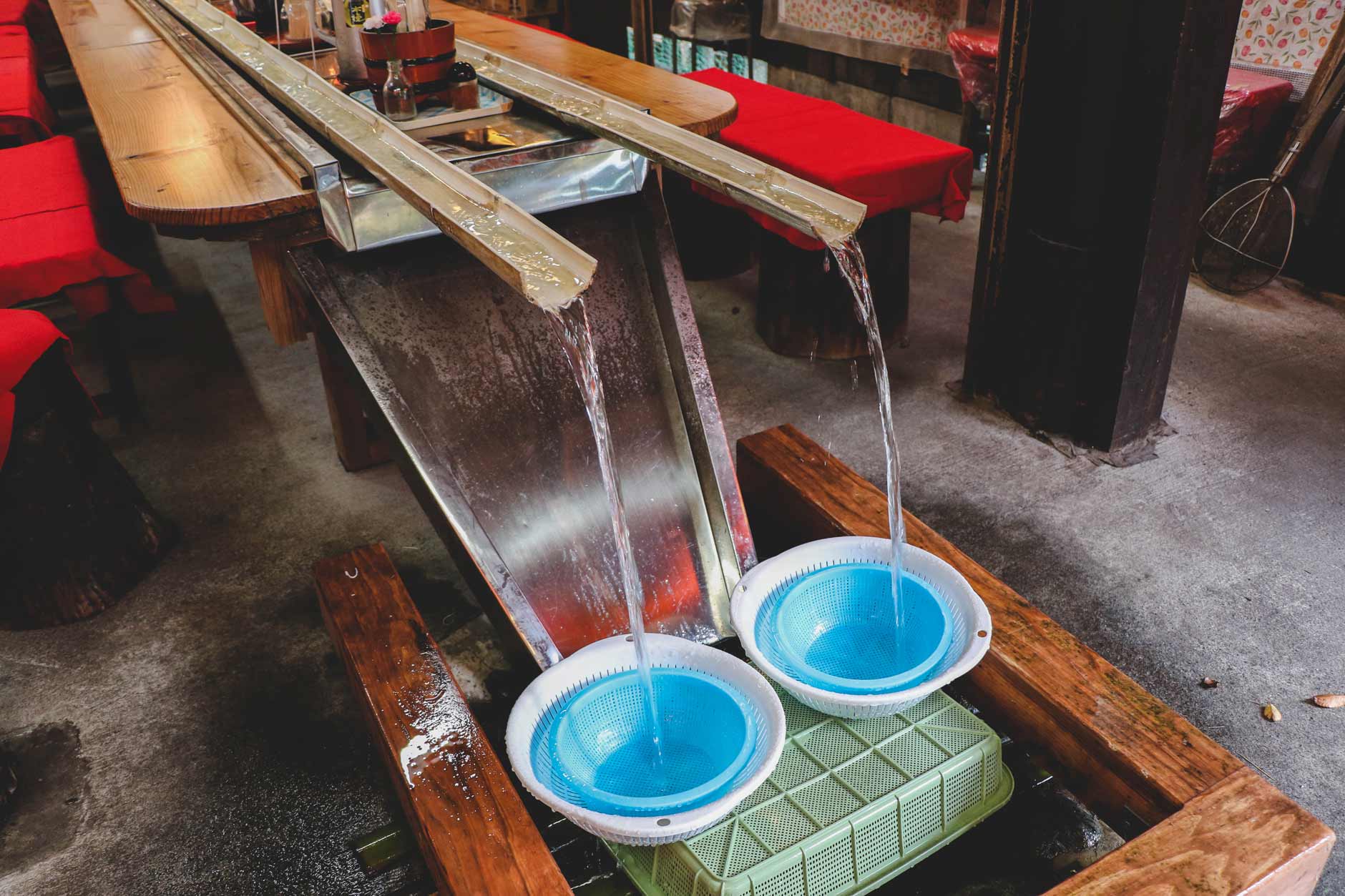
Don’t worry! If you miss your noodles, you can collect them at the end.
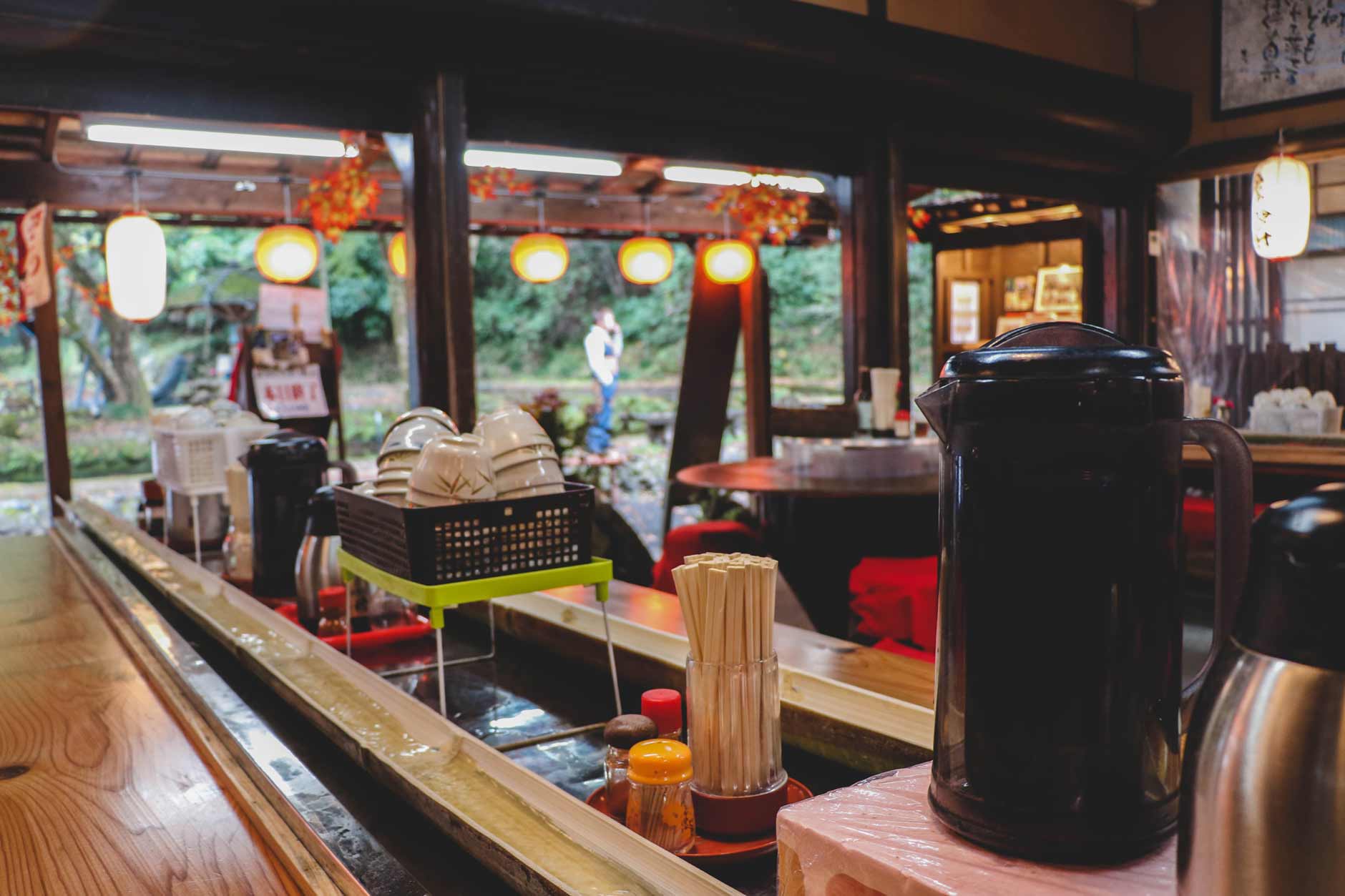
Bamboo chute where the somen flows down.
How to Get To Takachiho Gorge
From Kumamoto To Takachiho Bus Centre
From Kumamoto Airport, there are direct highway buses to the Takachiho Bus Centre operated by Kyushu Sanko Bus and Miyazaki Kotsu. Be mindful as there are only two buses scheduled per day. The whole trip will take around 2 hr 30 min and costs 2410 yen one way.
From Miyazaki To Takachiho Bus Centre
From Miyazaki Airport, you can take the JR Nichirin or Hyuga limited express train to Nobeoka Station and transfer to a number 71/72 Miyazaki Kanko bus to the Takachiho Bus Centre. The whole trip will take roughly 3 hr 30 min. The express train will take 80 minutes and costs 3000 yen while the bus trip will take 90 minutes and costs 1820 yen.
From Takachiho Bus Centre to Takachiho Gorge
It is possible to walk from Takachiho bus centre to Takachiho Gorge. The walk will take about 25 minutes in total. Taxi from Takachiho bus centre to the gorge will cost approximately 1200 yen and take 6 minutes.
There is a Takachiho Gorge Shuttle Bus service that operates during the busy season April – November only. This bus departs from Takachiho Bus Centre and will take you directly to the gorge for 100 yen. Please note that the schedule may change daily and it can be infrequent despite what the Takachiho Gorge shuttle bus timetable says. There are also public buses available from Takachiho Bus Centre to Takachiho Shrine, where it is a 10minute walk to Takachiho Gorge.
By car – Recommended
As you can tell, transportation in Takachiho is both infrequent and inconvenient due to its remote surroundings. Your best bet is to hire a rental car to get the most out of your trip. Not to mention the mountain drive is both scenic and beautiful especially during the autumn time! At Takachiho gorge, there are 3 carparks; Oshioi Parking for 500 yen, Araragi Parking for 300 yen and Ohashi Parking is free. See parking locations and more information.
The easiest way to rent a car is at the airport. If you are looking for a place, we hired our rental car through Nippon Rent-A-Car at Kumamoto Airport which was very easy and had great staff service.
- Miyazaki Guided Day Tour From Fukuoka: This highly rated tour takes you to the clear waters of Shirakawa Suigen Spring, Josen temple, takachiho Gorge, Amano Iwato and amano Yasugawara as well as including an authentic Japanese-style lunch!
- Takachiho Gorge and Mount Aso Day Tour from Kumamoto



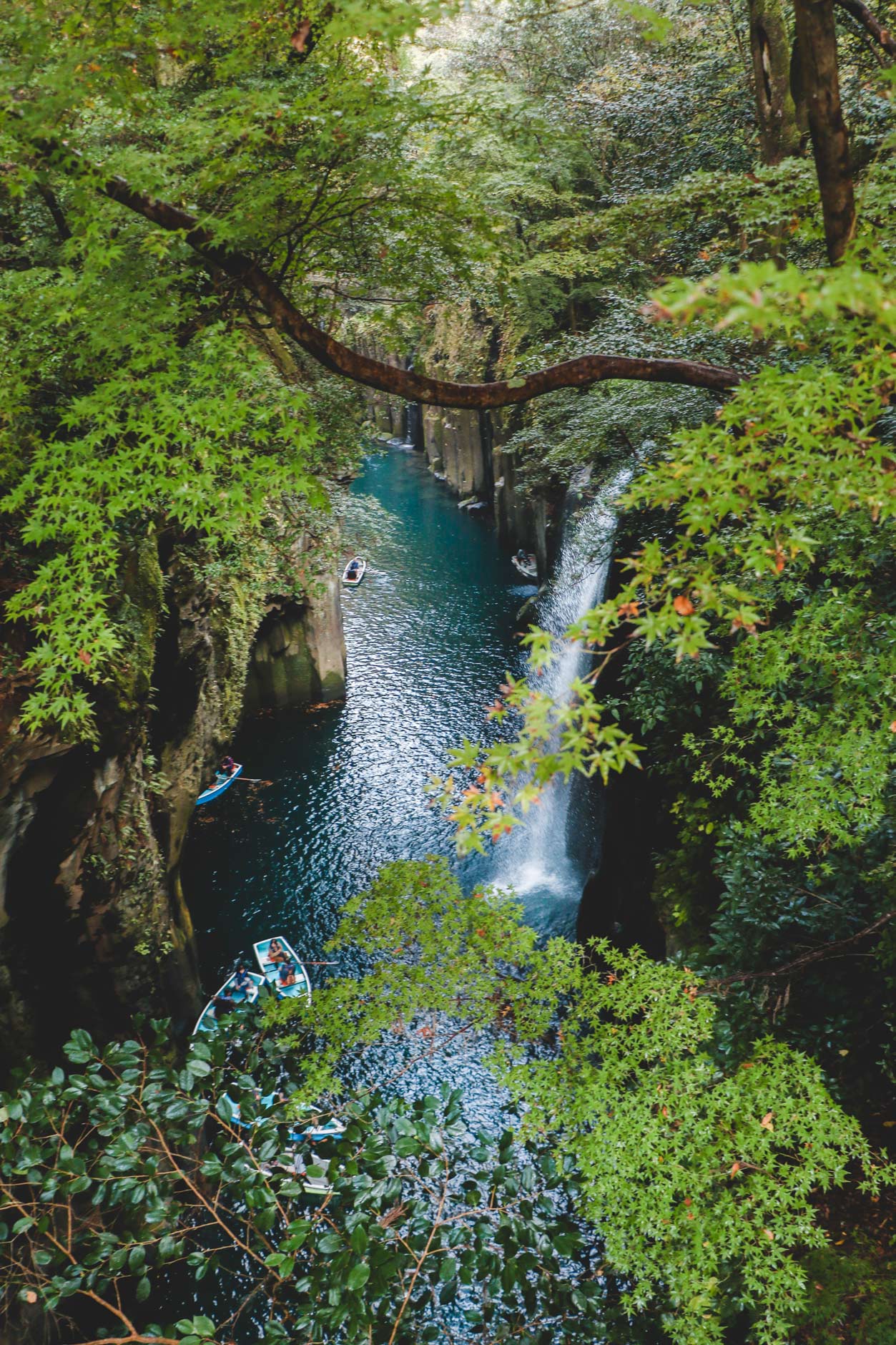
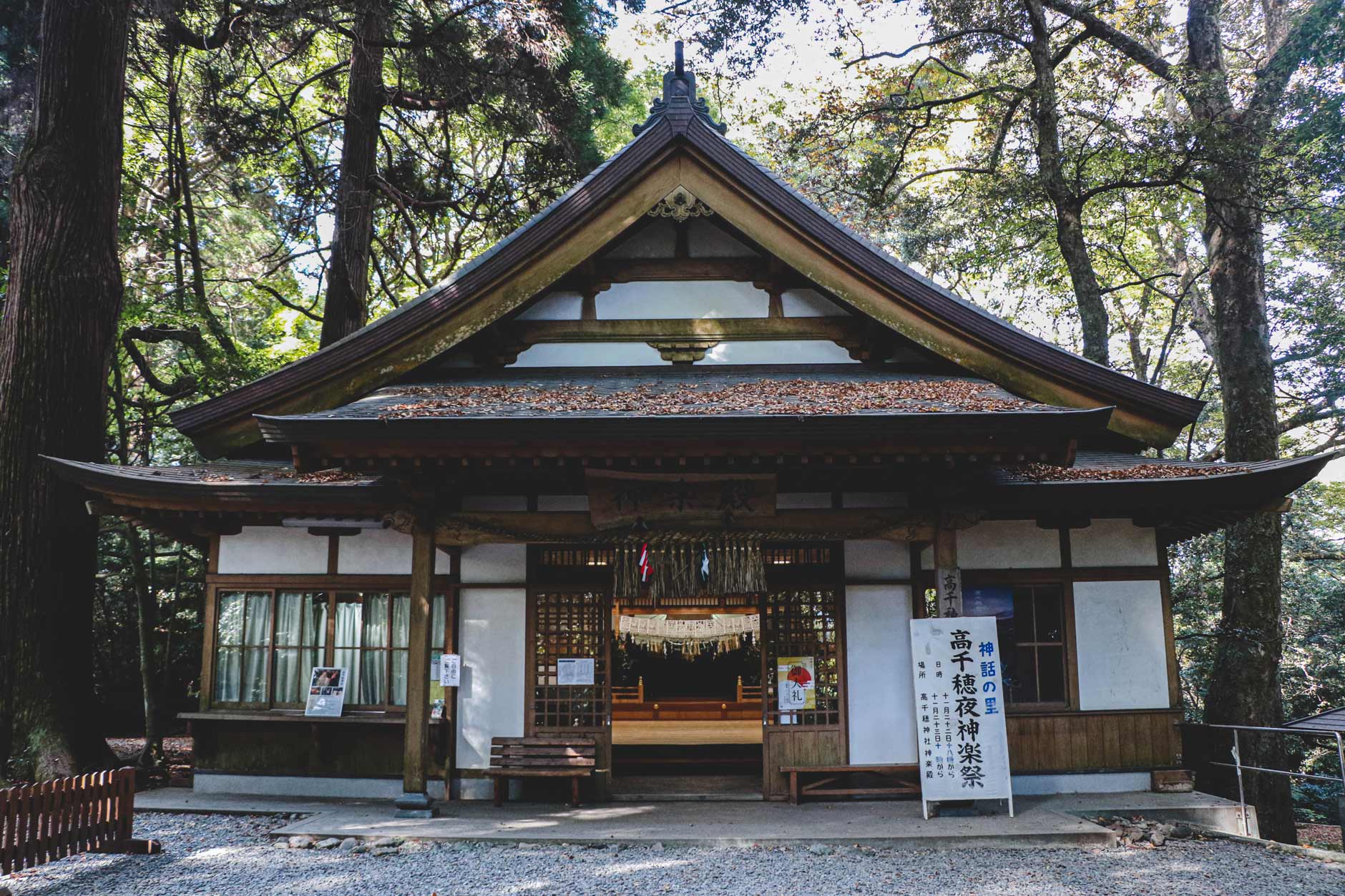
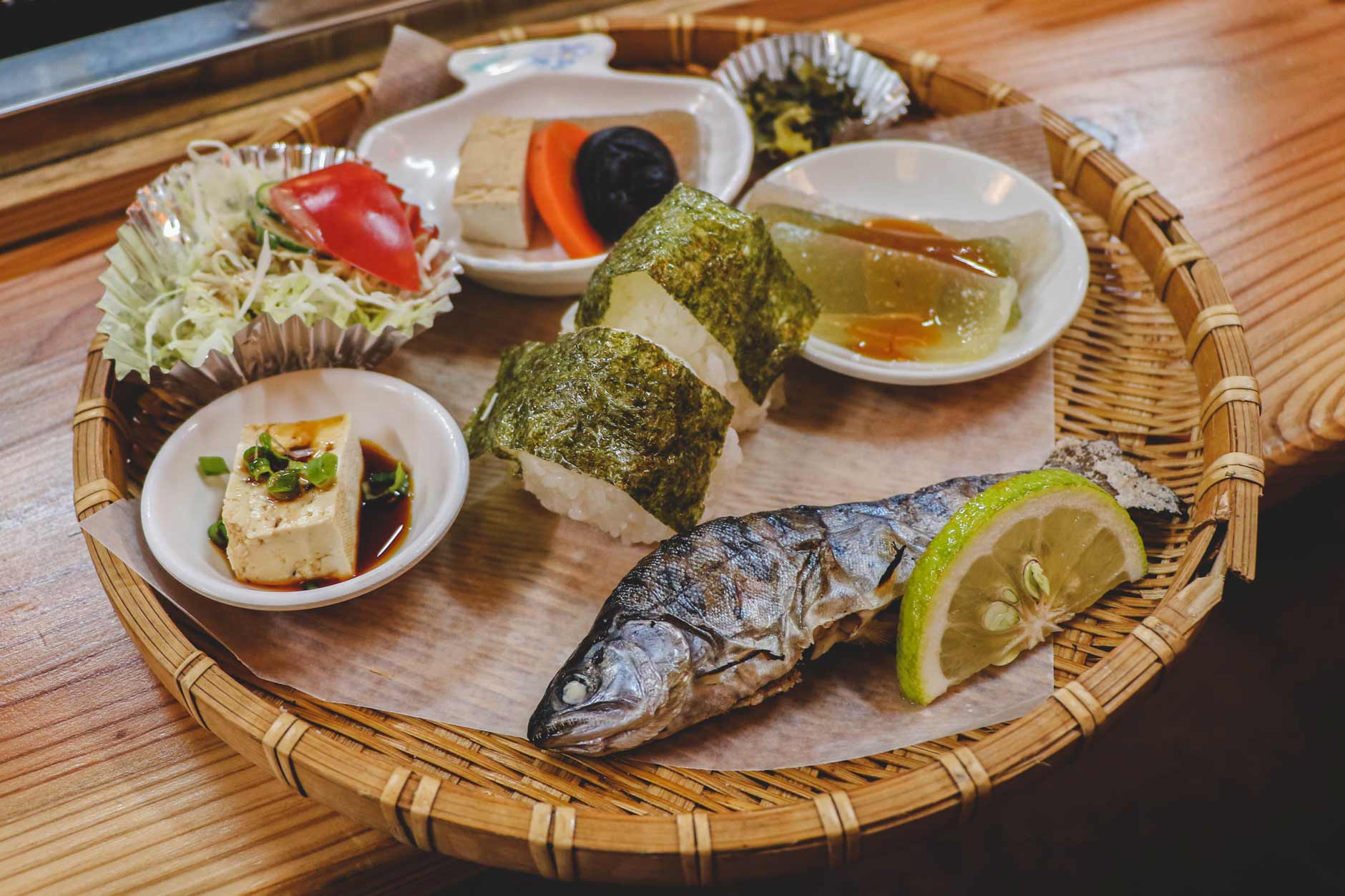
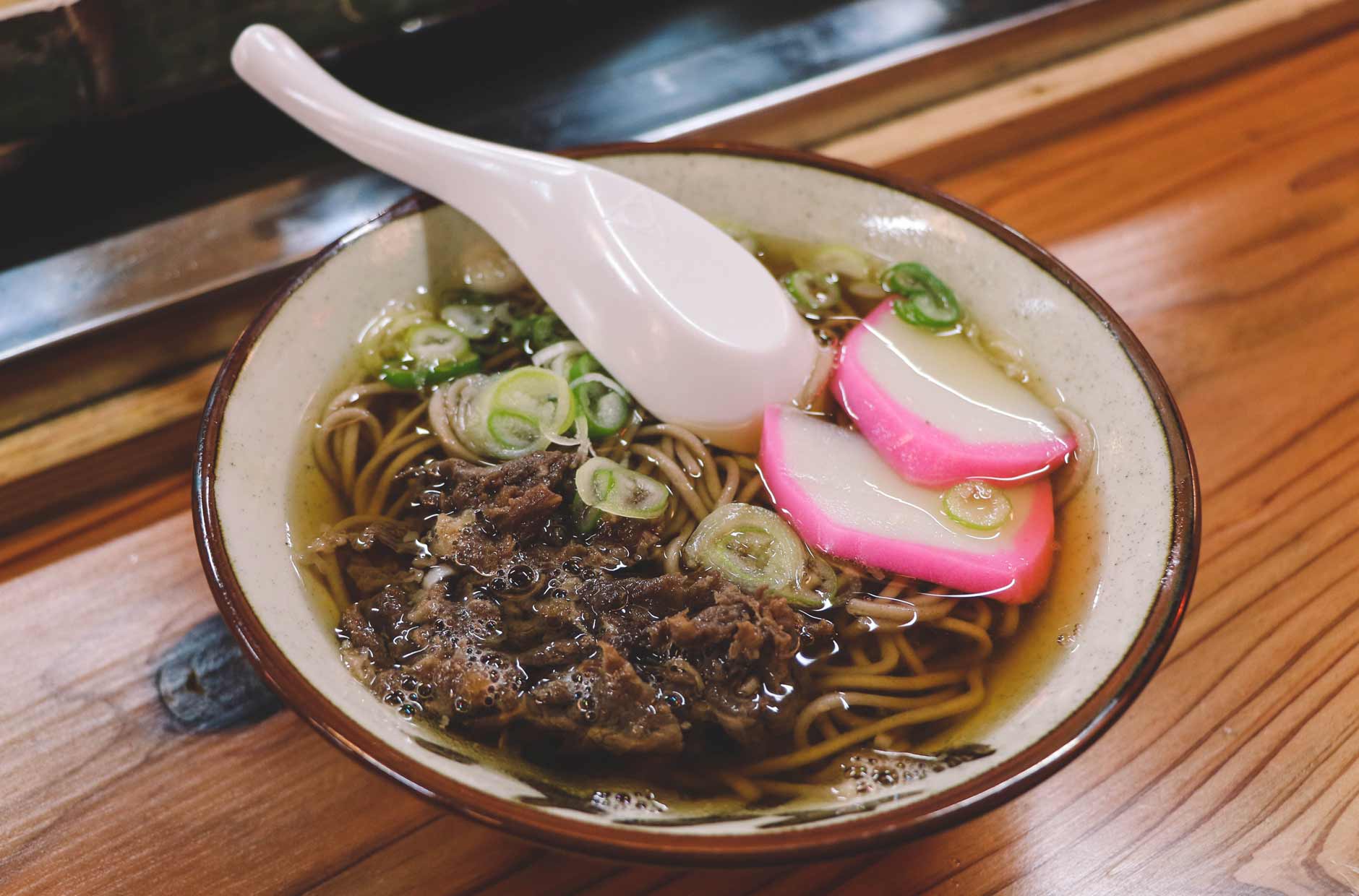
This is so cool, Talyssa! Thanks for the virtual tour.
What’s kind of interesting is that we have a ton of this kind of “colonnade” basalt flow stuff here in the Pacific Northwest – a relict of the huge Columbia River Basalt flows that covered this part of the world about 5-15 million years ago. I’d never seen a report of it in Japan, which is geologically closer to our Cascade Range andesitic volcanoes, so pretty unique and awesome.
So glad you enjoyed the post Chief!! I feel like there’s a lot of natural beauty in the US that I definitely need to check out one day! I wonder if the Japanese one was related some how to the ones in the US, or if the same geological phenomena happened in multiple locations.
What’s interesting is that my home here in the Pacific Northwest is very like Japan in being a “volcanic arc”; a place where tectonic plates converge. We both have big earthquakes, and large volcanoes – the same sort of conditions produce Fujiyama and Mt. Hood – tho Japan is an island arc and we’re what they call a “continental arc”.
That beautiful columnar rock formation we share, though, is very different. Here it’s the product of an amazing phenomenon called “flood basalt”; we think it’s related to what’s called a “hotspot”, a sort of huge eruption from deep inside the Earth. There is a very old one in India. Ours is younger, but still produced incredibly huge sheets of lava. Something like that must have happened here to produce these gorgeous pillars of rock!